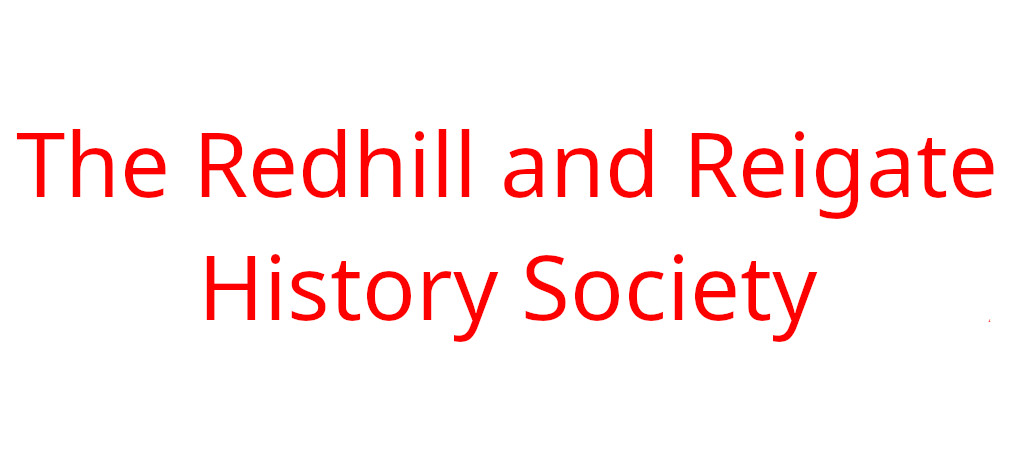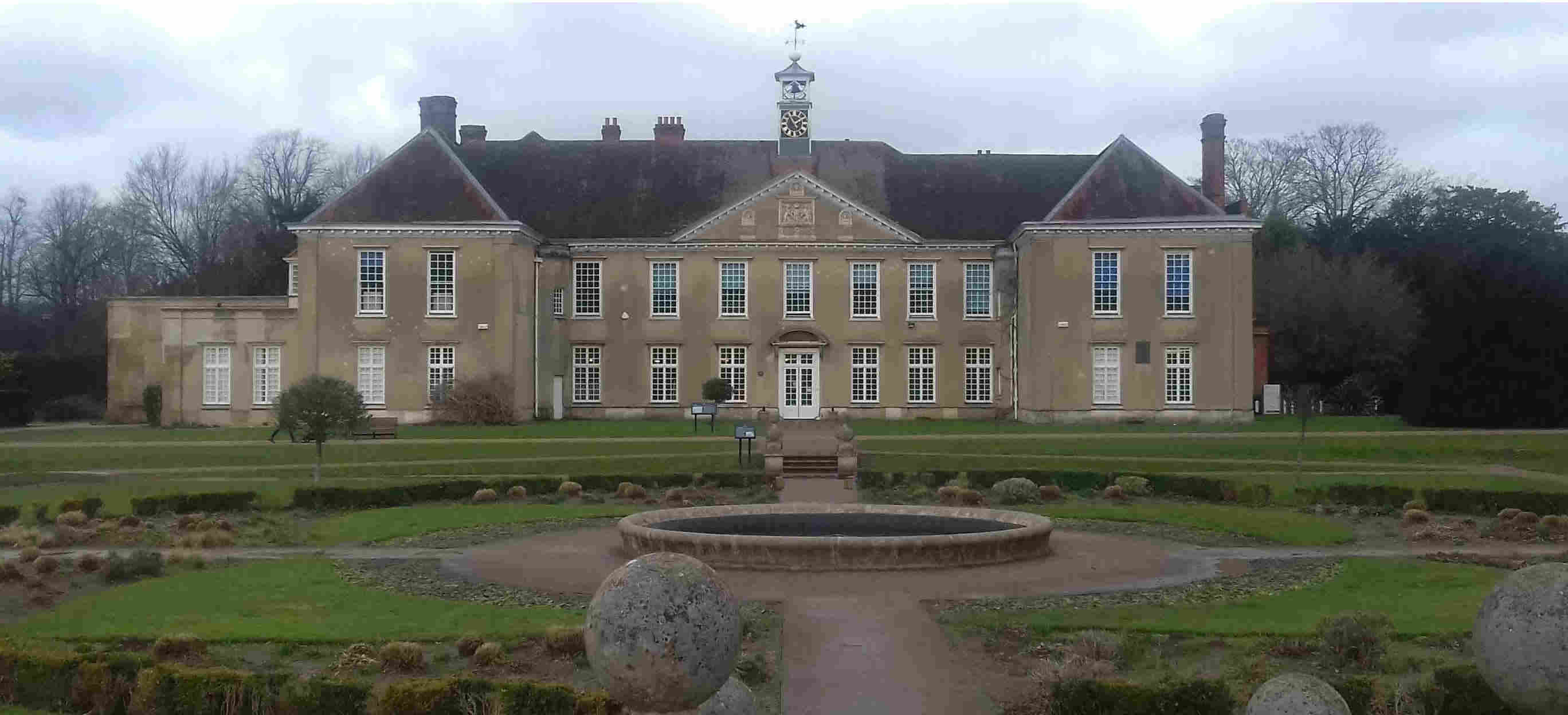Some Historic Notes on Lawn Bowls Greens and Lawn Bowls Greens and Clubs in Redhill Merstham, & Surrey
Introduction
While researching for the booklet to celebrate the 120th Anniversary of the Redhill Bowling Clubin 2015 I became aware of the strong support for the sport of lawn bowls in the growing town of Redhill in the late 1800’s and the notable achievements of some of the players in later years. Since then I have become more aware of connections between some Redhill and Merstham clubs so I have extended my research northwards to include the 4 clubs known to have operated in Merstham – none of which now exist.
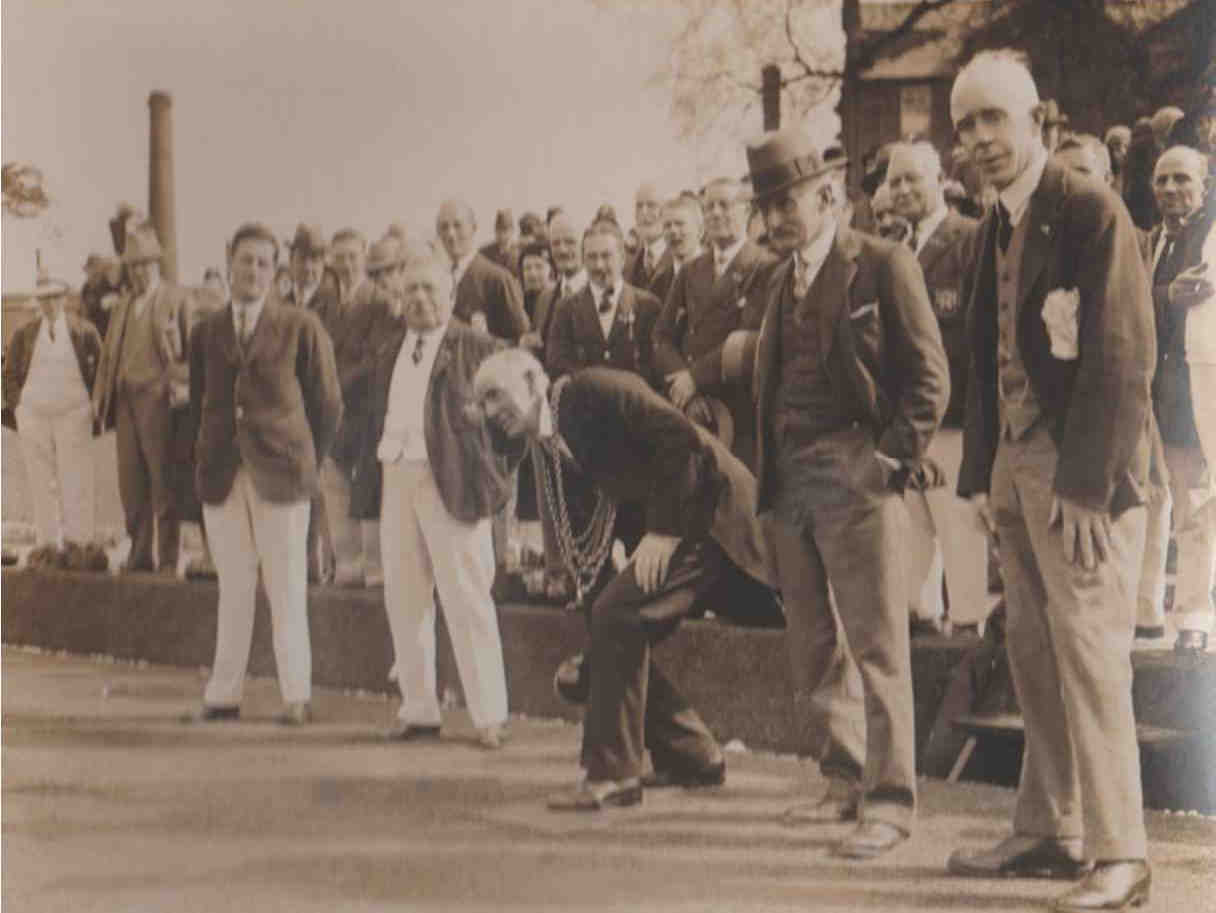 |
In alphabetic order the clubs included in this monograph are:
- Battlebridge at the Battlebridge Recreation Ground, Merstham
- Merstham at the Feathers Hotel, Merstham
- Merstham Village at the Village Hall, Merstham
- Holy Trinity/Monson at Holy Trinity Church
- Wiggie Ramblers at Wiggie Homestead
- Redhill & District retitled Redhill from 1918) at Gloucester Road
- Redhill Subscription at the Warwick Hotel
- Redhill (Wiggie) from 1931 at Wiggie and became Redhill in 2010
- St. John’s at St. John’s Parish Hall
- South Merstham at the Griffin Hotel, Merstham
- Warwick Hotel (Redhill) at the hotel
- Woodlands at Foster’s Temperance Hotel
Bowling greens without a resident club or in private grounds have been identified near to High Trees Farm; in London Road, Redhill; in Merstham at Coppice Lea, at Harps Oak and the Rectory; and “at a public house in the St. John’s area” (although this is possibly Foster’s Temperance Hotel).
To the south of Redhill is the Monotype Bowls Club founded in 1959 at Salfords and to the east is Bletchingley Bowling Club founded in 1929. Although both clubs are in the RH1 postal district they are outside the scope of this monograph.
The author has taken the liberty of omitting punctuation from names included in the text. Featured greens and clubs are shown in bold type. All maps are shown with a north-south orientation. Reliance is placed on the accuracy of newspaper items and other reference sources. Any other errors are the author’s sole responsibility.
Bowls origins near High Trees Farm
An early mention is made of a bowling green to the south of Linkfield Street in Nigel Dunne’s The Redhill Story. In a description of life there at the end of the 18th Century he writes about the well and pump opposite the White Lion public house - “But the community well was welcomed by travellers as was the bowling green near the old High Trees farm, which was used by customers who stayed at the inn.”
In August 1928 the Surrey Mirror printed extracts from a manuscript history of the Borough of Reigate which included this text describing a route south from Linkfield Street - “As you ascend Red Hill, under the right hand hedge, is a small house and a few acres of land, which belongs to Mr. Havers at the mill. Just above it at the top of the hill is a farm and house called The High Trees, which are now cut down, which belongs to Francis Masseres, now rented to Mr. Symonds. Fronting the yard gate, on the top of the hill, was formerly a bowling green, for the use of the company which came to the White Lion, Linkfield- street.” Francis Maseres was an eminent lawyer. He lived at The Barons in Reigate for 50 years and died there on 19 May 1824, at the age of 93. This suggests the bowls green dates from the first quarter of the 19>th century or earlier. The White Lion is thought to date back to the 16th century.
The William Eve survey of the Parish of Reigate dated 1860-61 shows High Trees Farm. The building still exists today. The accompanying terrier identifies the land fronting the farm as shown below. From the text above the likeliest location for the bowls green was in the relatively flat High Trees Meadow.
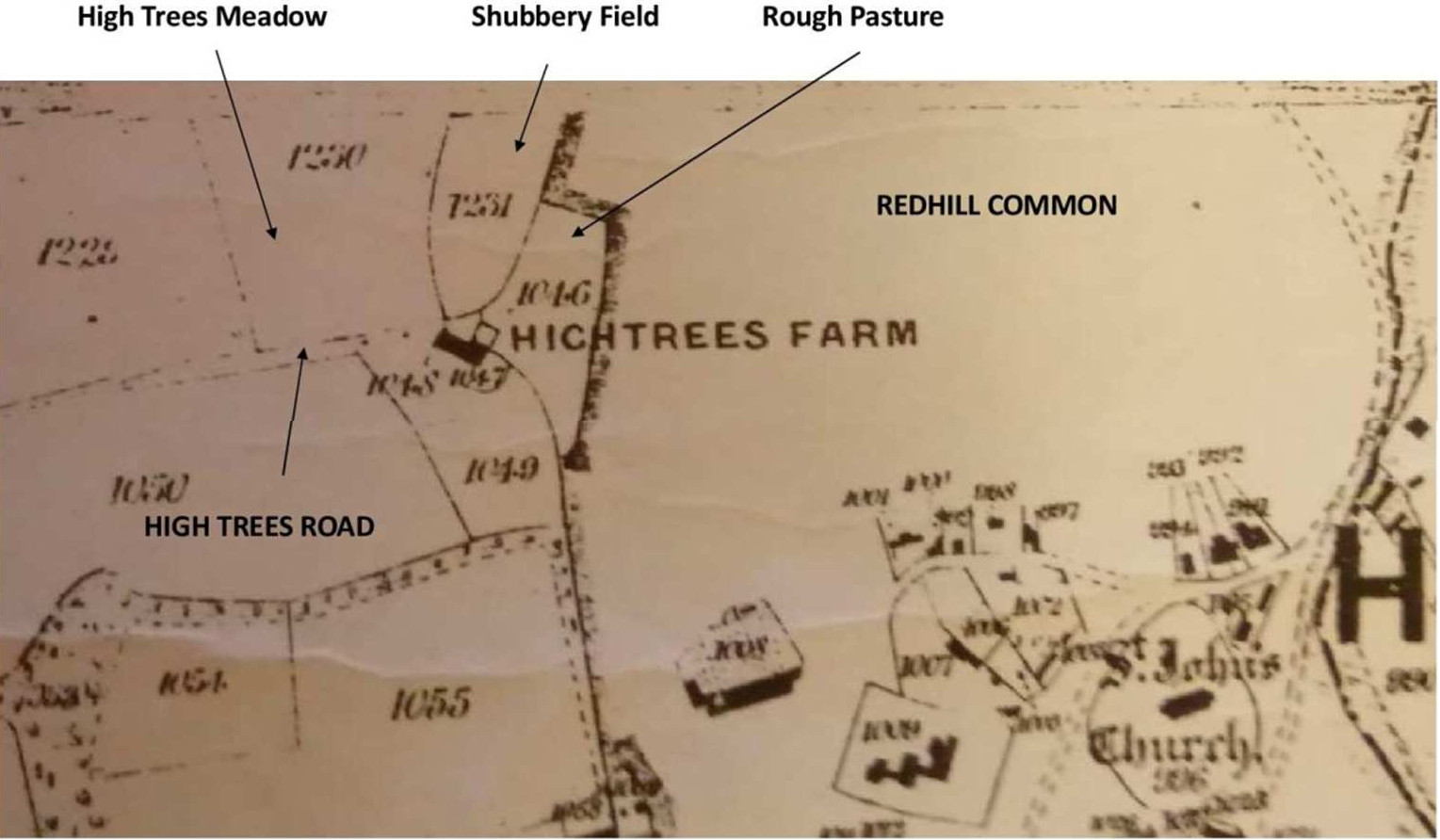 |
This would have entailed a walk of about half a mile from the White Lion along Linkfield Street and then up and across Redhill Common on a fairly direct footpath. The area is now covered by the gardens of the large detached houses built to the north of High Trees Road.
The following bowling greens and clubs are listed in broadly historic order by their first mention in the press archive or when first shown on a local map.
Warwick Hotel Bowling Green – used by two clubs
The Warwick Hotel (Redhill) Bowling Club began in about 1878 a few years after the green was installed. In September 1885 the Surrey Mirror reported that “The seventh annual closing dinner of the Warwick Hotel (Redhill) Bowling Club took place at the Hotel on Wednesday evening.” Among the attendees “Mr Rentell, captain of the club was also present.” This confirms an establishment date of about 1878. It thus qualifies as the first bowling club in Redhill. The rectangular green was sited to the rear of the Station Road properties bearing the BOVRIL advertisement – see photo below.
The club may have had a hiatus as the Surrey Mirror reports in November 1890 on its annual dinner where “Since last year the ‘bowlers’ who use the excellent little green at the side of the Warwick Hotel, Station-road, have established a bowling club…” Cllr J T Sanders is named as the Club Captain.
At its annual dinner in October 1891 the Club Captain Cllr Sanders stated “in 1878 the Club was very small with only four or five playing members, but now they had nearly 70 members, 35 or 40 of whom were paying members.”
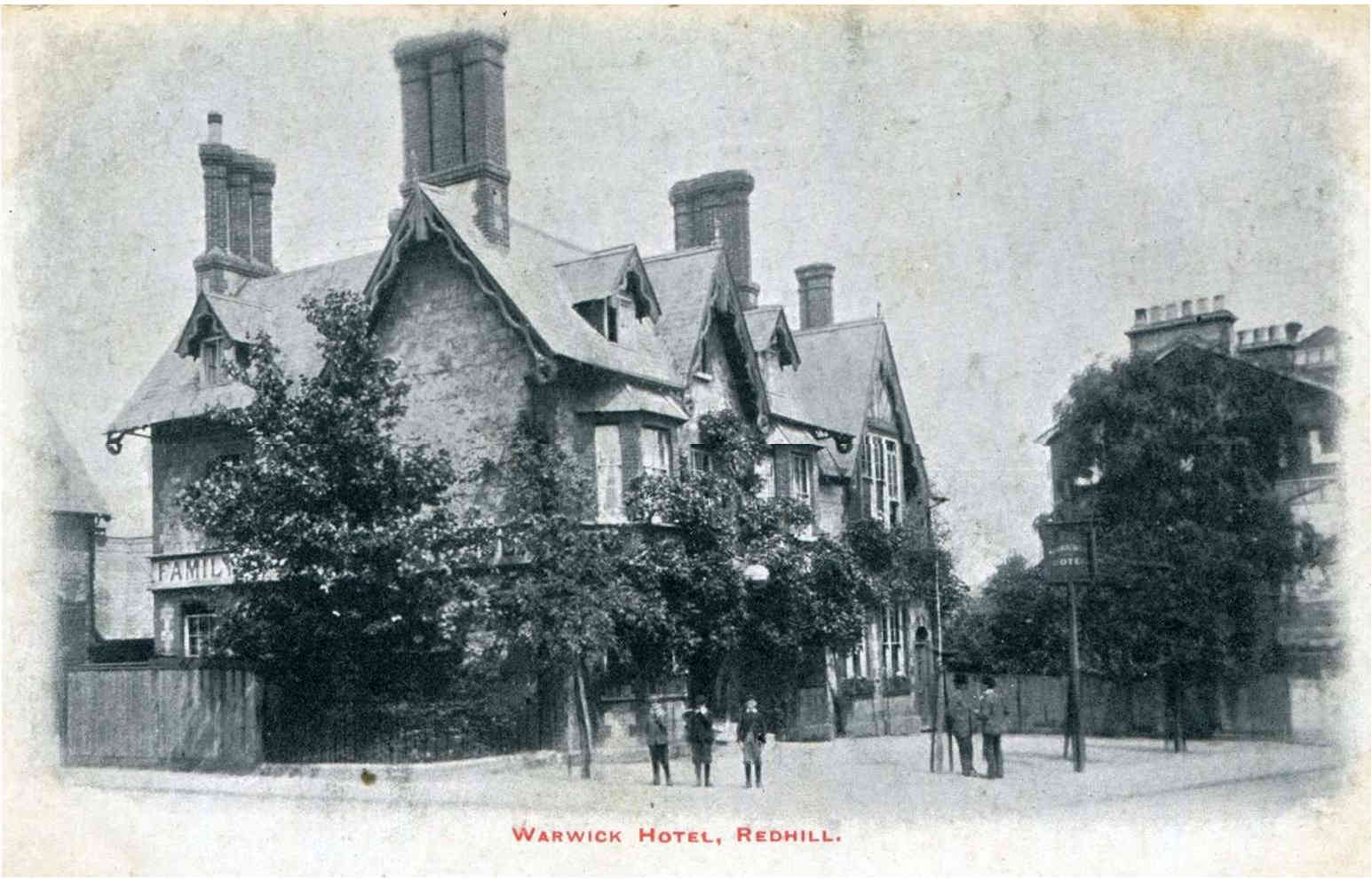 |
The club played matches at home and away with an unbeaten home record. For example it played a return match at home against Croydon on 7th July 1891 and won 114 to 103.
The Surrey Mirror of 19th September 1891 reports on the club championship finals. First prize went to Mr David Chalmers, the youngest member of the club, and was presented by Sir Trevor Lawrence MP. The only David Chalmers living in Reigate at the time of that year’s census was a 23 year old wheelright. Mr Hamnett, the hotel proprietor, won 4th prize.
It is not known how long the Warwick Hotel (Redhill) Club survived after 1891.
The hotel bowling green was also used by the Redhill (Subscription) Bowling Club At its annual dinner in 1895 the Surrey Mirror reports that the Club Captain – the same Alderman Sanders – in response to a speech by the Chairman “said their green has been in existence for about 20 years, and the present club has been in existence for 11 years. During the whole life of the club he had had the honour of being Captain” and “During the whole 11 years it has been in existence the club has never been beaten on its own ground.” This boast echoes the statement made by Cllr Sanders in his speech at the Warwick Hotel (Redhill) Club dinner in October 1891. This gives the founding year of the Redhill (Subscription) Bowling Club as about 1885 – some 10 years earlier that the current Redhill Bowling Club’s official date.
As Mr Rentell was the Club Captain of the Warwick Hotel in 1885 and Cllr Sanders had been Club Captain of Redhill (Subscription) during the whole life of the club (11 years) up until 1891 then this confirms there were two separate clubs based at the hotel.
A local directory of 1909 dates the Subscription club even earlier – approx. 1882:
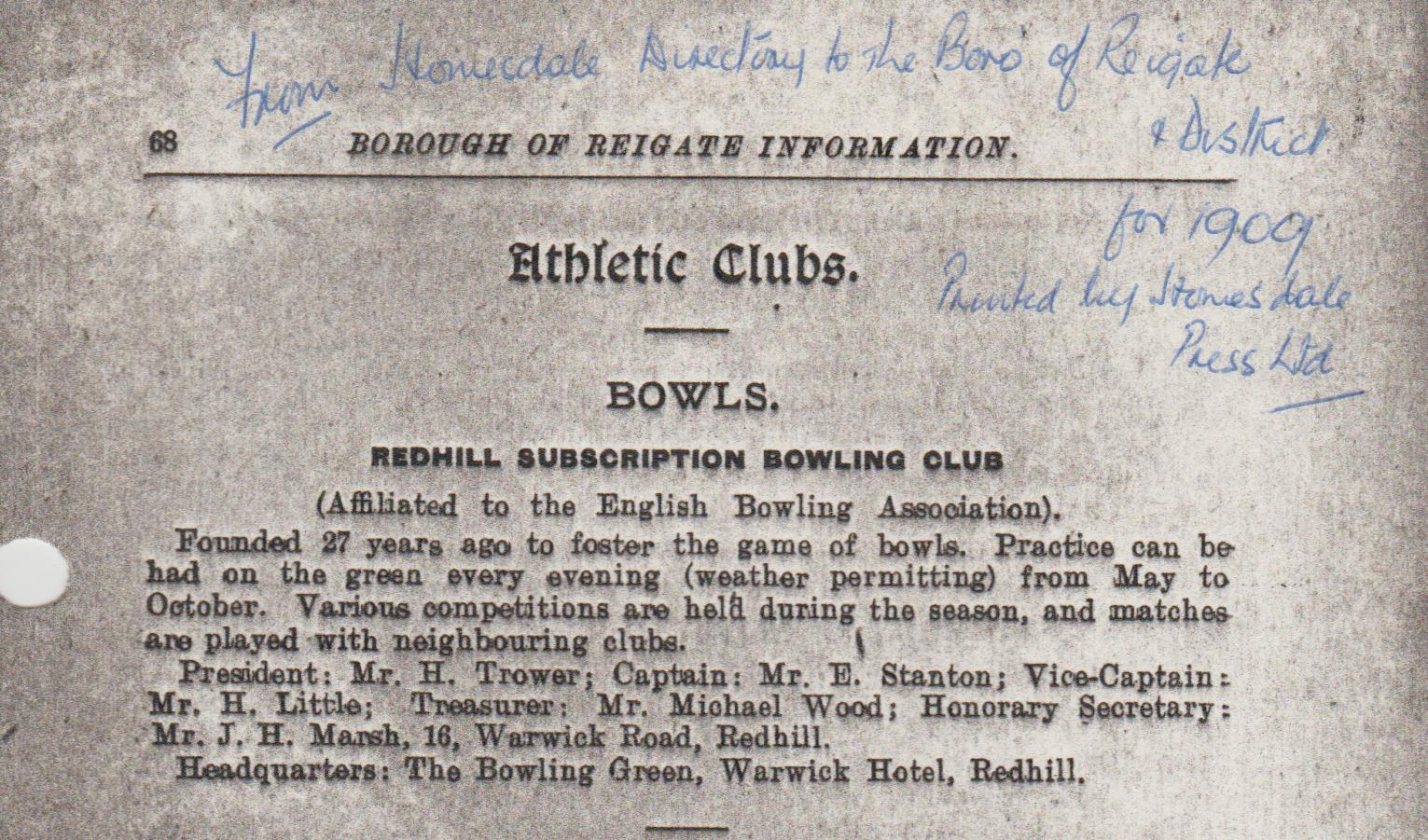 |
The same year of origin is suggested in a speech by E E Peacock at the 1907 Annual Dinner of the Redhill Bowling Club (sic). In his toast to the Redhill (Subscription) Bowling Club he said “That the club was strong was shown by the fact it had been in existence for over 25 years and by the presence of such a gathering…” Among others in attendance at the dinner were Captain R H Rawson (later MP for Reigate) and Club President Henry Trower of Wiggie.
In 1912 many players at the Warwick Hotel left to form the new Redhill & District Bowling Club at the Gloucester Road green but the Redhill (Subscription) Bowling Club survived at the hotel until at least 1916. A notable achievement in 1916 was marked at the Surrey County Bowling Association annual meeting at the George Hotel, Strand on Wednesday 1st November when H P Watts of the Redhill (Subscription) Bowling Club was awarded a gold medal for winning the Roseberry Cup Singles Competition. He had beaten the previous holder J C Waterman of the Redhill & District Bowling Club 21-4 in an earlier round on 20thJune at Waterman’s own green at Gloucester Road.
The co-existence of the Redhill Subscription Bowling Club and the Redhill & District Bowling Club is further confirmed by a Dorking & Leatherhead Advertiser listing of fixtures for Wednesday 1st July 1914. These included Merstham v Redhill (Subscription) and Horsham v Redhill & District.
The relationships between the Warwick Hotel, Redhill (Subscription) and Redhill & District Bowling Clubs are difficult to ascertain. Of the former club at least 12 members also joined Redhill (Subscription) including the Captain of both clubs - Cllr Sanders - while 3 members joined Redhill & District. At least 5 members of the Redhill (Subscription) joined Redhill & District.
The Warwick Hotel was demolished in the 1970’s for the new Queensway road
Wiggie Homestead Bowling Green – Old Wiggie Ramblers
Henry and Arthur Trower were successful local corn merchants and they were prosperous enough to purchase the Wiggie Estate after the death of their parents – farmer Richard who died in 1880 and his widow Ann in 1891. The estate consisted of some 50 acres of land, the usual farm buildings, orchards, a vegetable garden and a paved manure yard surrounded with cowsheds, a barn and a granary.
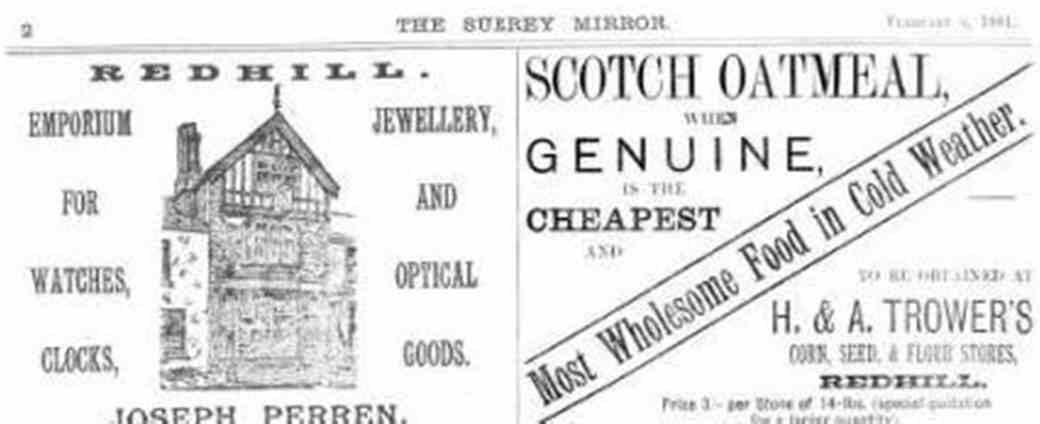 |
The 1901 Census lists the occupants of Wiggy Farm as Henry, Fanny and Arthur Trower. Fanny was Arthur’s elder sister and like her brothers never married.
The Trowers established an ornamental garden at Wiggie including planting of daffodils in the orchards. In his 1910 book “Our Homestead” Arthur Trower describes the establishment of a tennis court and bowling green in the orchard of the estate. It was not uncommon to have such a facility in the grounds of grand houses. On 27thJuly 1914 the Redhill & District Bowling Club was invited by their President J Arthur Warwick to a match at the green in the grounds of his residence Rookwood in Doods Park Road, Reigate. There were also at least 3 private greens in Merstham – see Merstham Bowling Club below.
The 1895 and 1933 Ordnance Survey maps both show an area at Wiggie within an orchard of the correct dimensions for a bowling green. The later map is shown below which also includes the Redhill (Wiggie) green to the south-west.
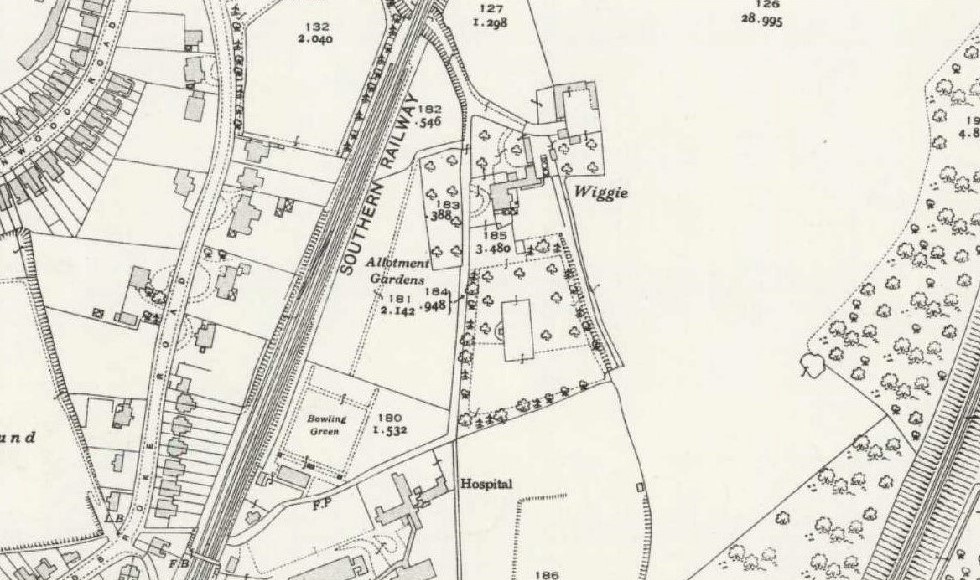 |
Arthur Trower admits in his book “that I am a keen follower of the game myself” and devotes several pages eulogising about “the grand old game of bowls” and of the players that he “never found one who was not a true sportsman, and game to the last, although the score may have looked almost hopeless.”
The Wiggie estate was famous for its garden and in particular the spring display of daffodils which attracted visitors from far and wide.
The Surrey Mirror of 16th July 1907 describes a match at Wiggie of Wiggie Ramblers against Kemptown (Brighton) where “The green was in splendid condition, and the beautiful garden, and grounds were perfect with summer bloom.”
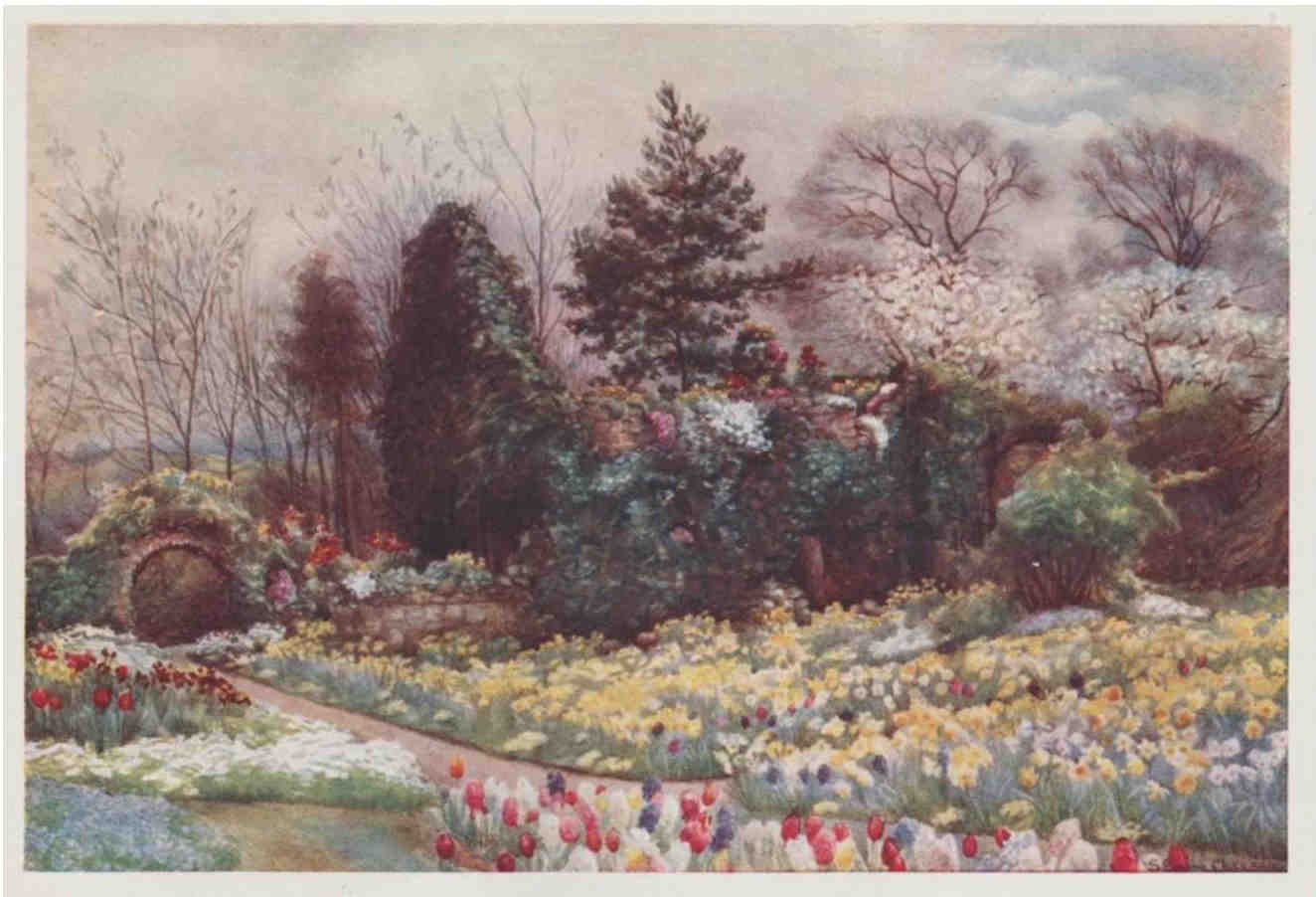 |
The photo below shows the green at Wiggie still in use over 20 years later with Arthur Trower surrounded by his team and the visitors from Redhill Bowling Club.
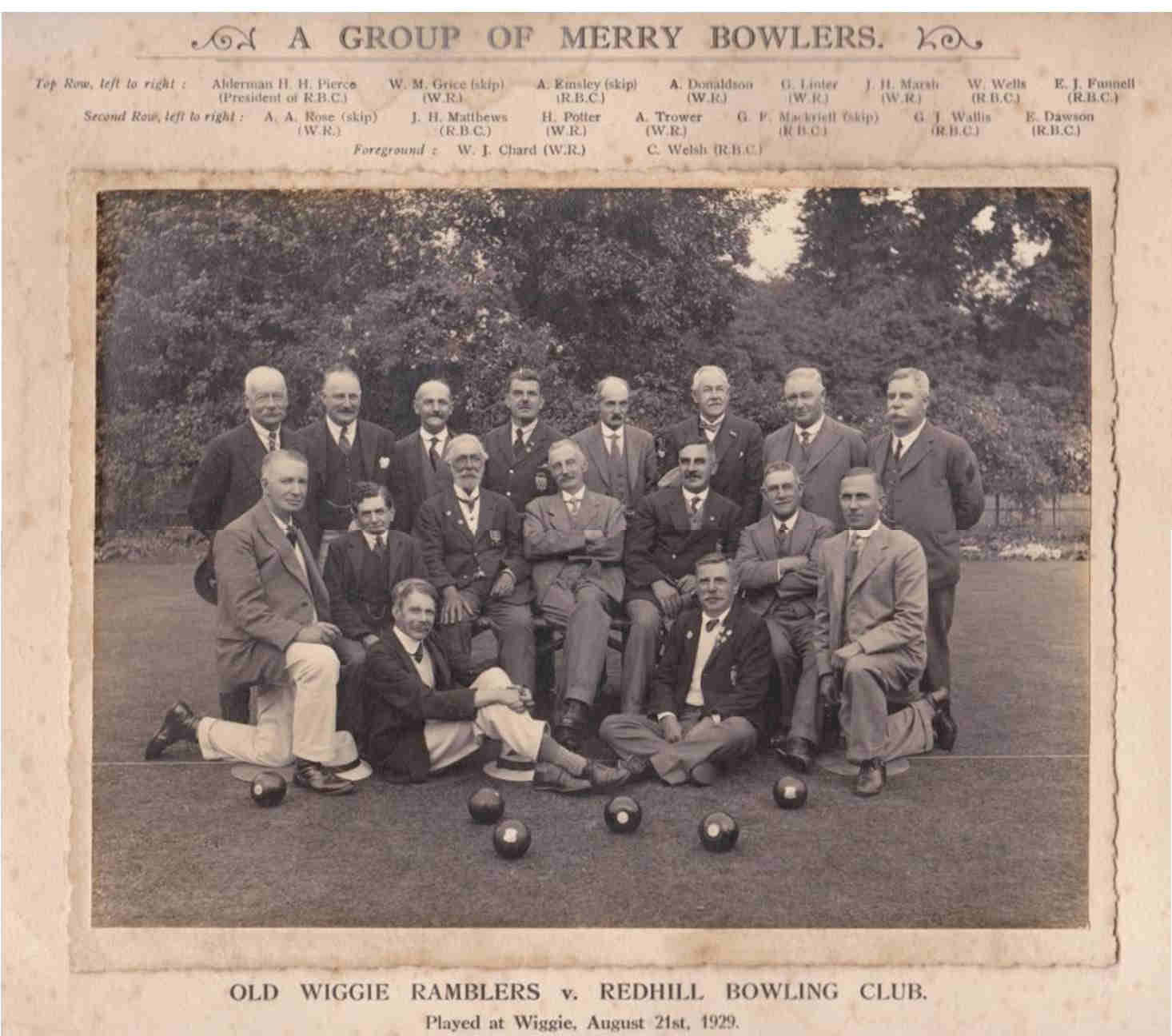 |
For details of the participants see Appendix A.
The Wiggie estate was sold by auction after the death of Arthur Trower in 1937.
Feathers Hotel Bowling Green – Merstham Bowling Club
The club was founded about 1897 and used the green in the Hotel’s gardens. Its founding date is suggested by the 17th Annual Dinner being held at the Feathers Hotel in November 1913. The 1896 survey below shows the Feathers Hotel with its gardens to the rear.
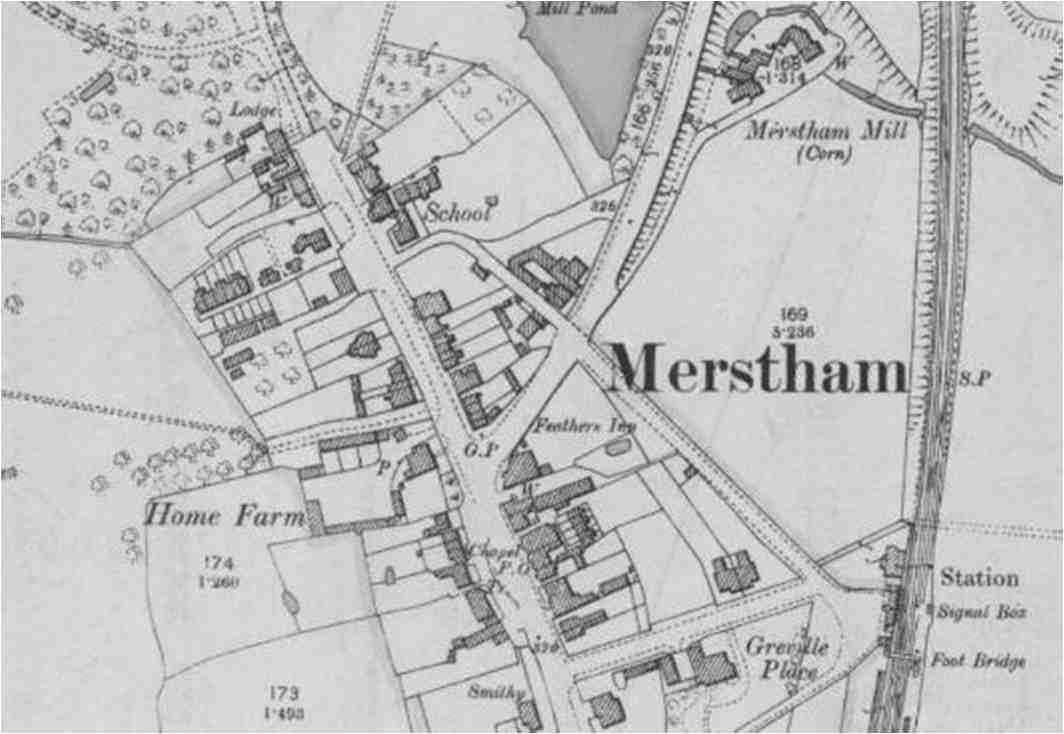 |
The Surrey Mirror of Friday 27th October 1899 contains a report of the Merstham Bowling Club annual dinner held two days previously at the Feathers Hotel. The Rev R I Woodhouse (Rector) was in the chair with Mr E J Hamnett the vice-chairman. The latter praised the secretary Mr E T Stanton who “had pulled the club together, and now they were going along splendidly.” The Rector who presented the prizes commented on “the excellent feeling that seemed to exist between Redhill and Merstham.” A prize winner from Redhill, Mr J M Rentell, had “transferred his prize to Mr Richardson so that it might remain in the village.” Mr Rentell was the Club Captain of the Warwick Hotel in 1885.
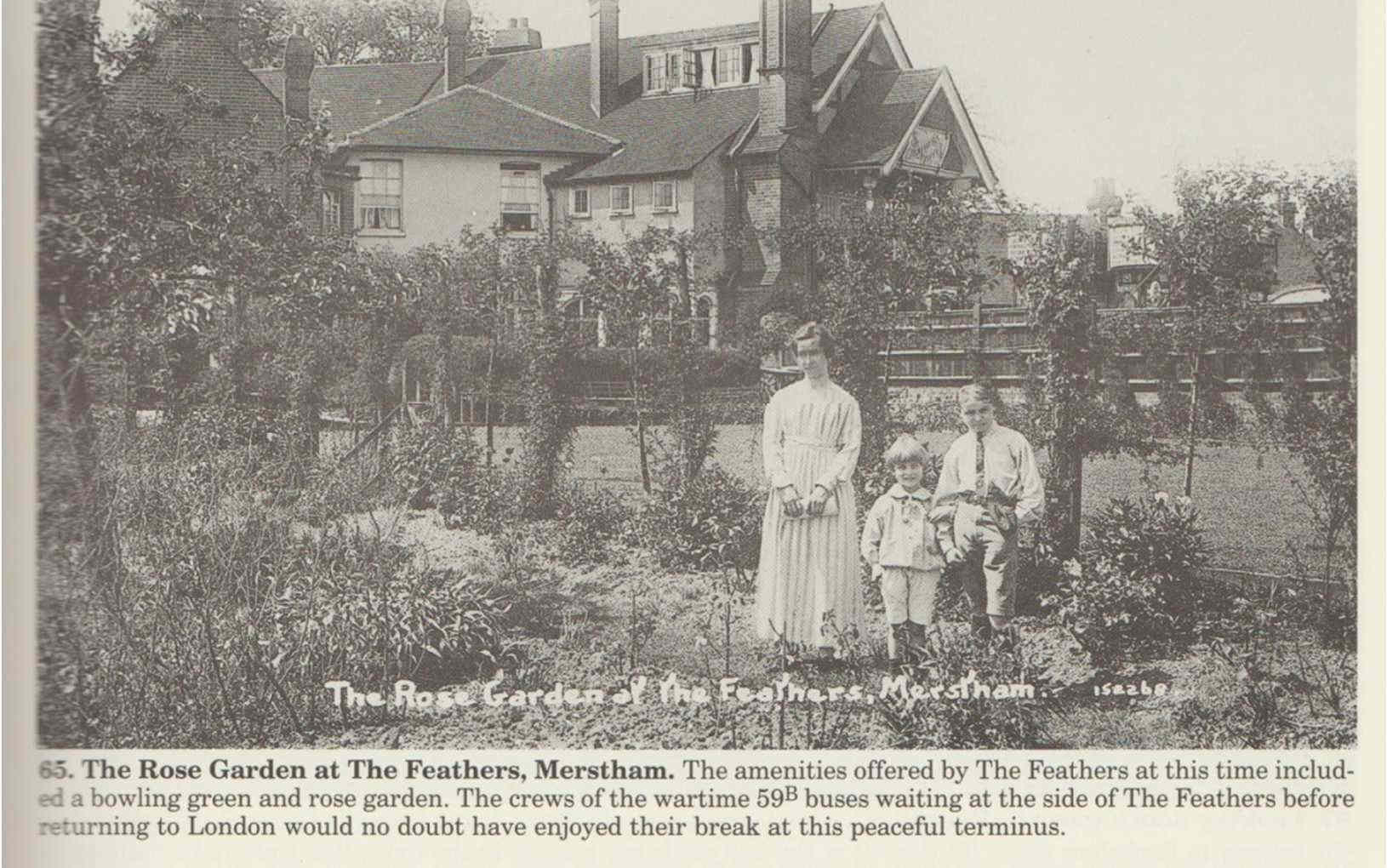 |
In September 1905 the prospective Conservative candidate for the Reigate Division, Capt Rawson, visited the club and after a match with several of the members presented “a handsome pair of bowls” and suggested that the club held a contest for them. He had presented a silver cup earlier in the same season to the South Merstham Club.
The bowling green was still there in 1910 when this advert appeared in the Surrey Mirror.
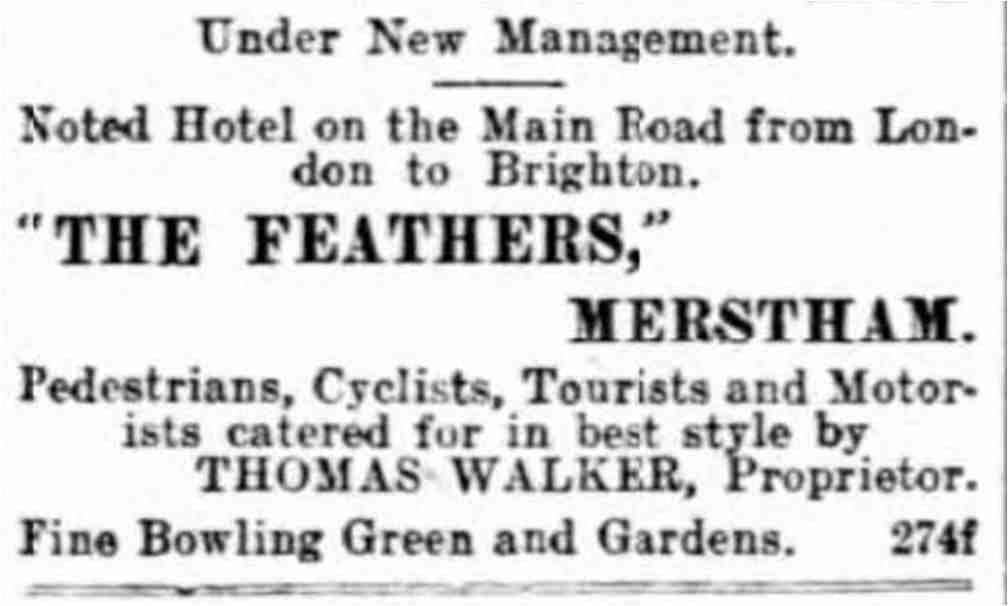 |
The Merstham Bowling Club played at the Warwick Hotel against the Redhill (Subscription) Club in May 1914. In June of the same year the club visited the Rectory at Merstham and played a match there at the invitation of the Rector and Mrs Woodhouse.
The Rector was a Vice-President of the Merstham Bowling Club and the grounds of the Rectory were extensive enough to house a bowling green.
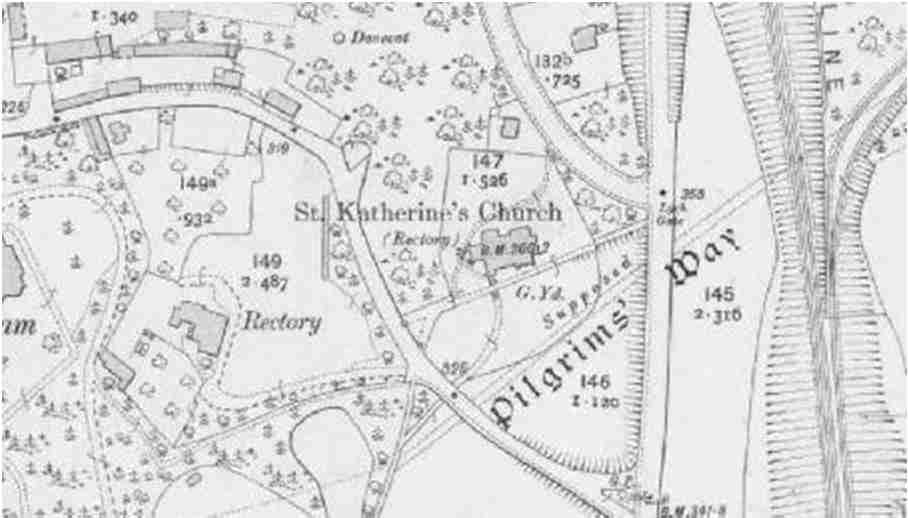 |
Later in June there was a third match between the club and a vice-presidents’ team. This was played at Harps Oak at the invitation of Mr Topham Richardson and Mrs Richardson.
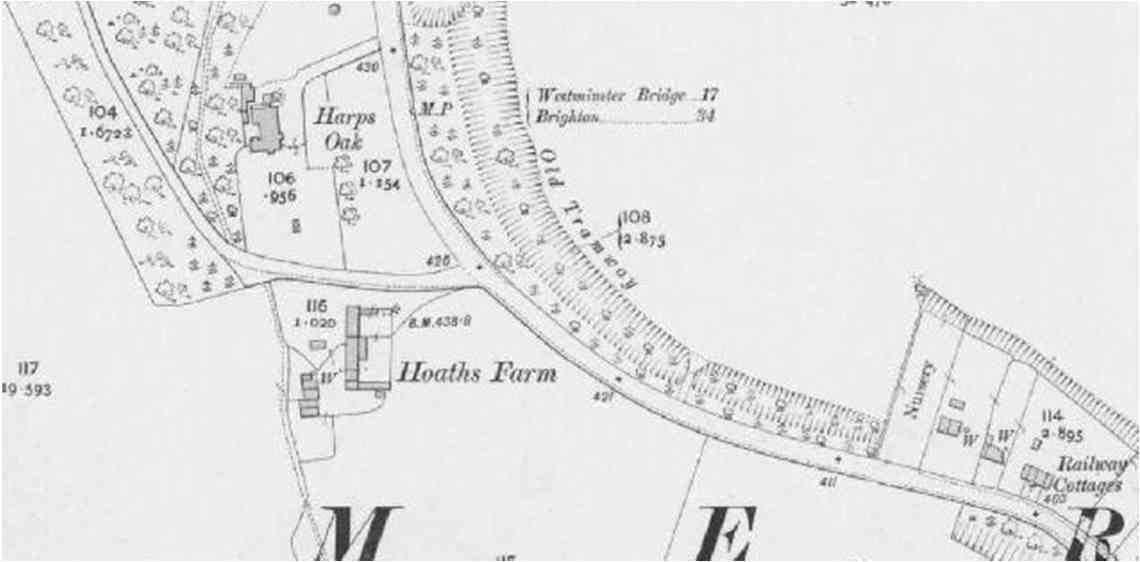 |
A final match in this series would take place in July at Coppice Lea at the invitation of Mr & Mrs G R Hunt.
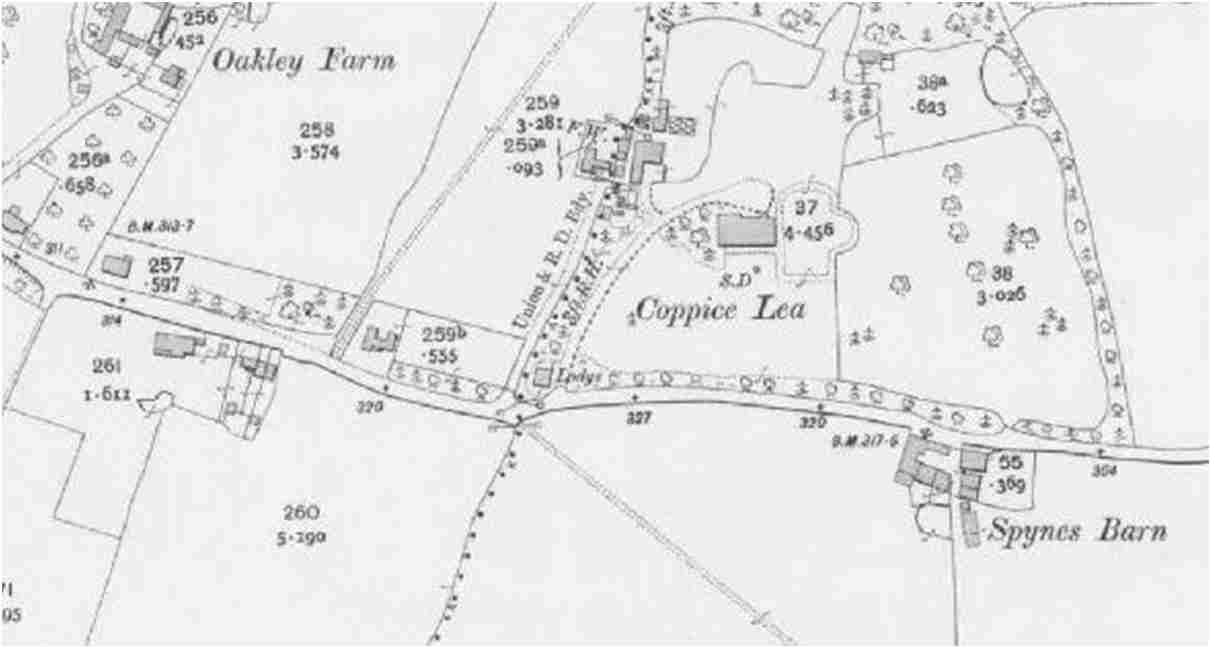 |
In March 1921 at a meeting of members of “Old Merstham Bowling Club” at the Feathers Hotel it was agreed that the club should be placed on its pre-war footing. Mr Topham Richardson was elected President and Mr J J Pink was elected Captain and a successful season was anticipated.
A Merstham team then featured regularly in published bowls fixtures including Redhill and District League matches. The latest so far identified was in 1938 when the club played away at Caterham Hospital. Other clubs who participated in this league during the 1930’s included Blechingley, Caterham (Queens Park), Godstone, Horley, Oxted & South Merstham.
Griffin Hotel Bowling Green – South Merstham Bowling Club
The Griffin Hotel began life as two semi-detached villas in the 1890’s. The Ordnance Survey map of Merstham dated 1896 shows no buildings on this corner site. License applications failed at County level in 1898 and 1899 under opposition from the Feathers Hotel and the local Co-operative Society which had a shop with an off license. But the local bench did grant an off sales license. A full license was obtained in 1900 following additions to the frontage of the building and pressure from the rapidly growing local population of South Merstham. The 1899 license application was made by Mr R S Nicol (see paragraph below). He was not the landlord but possibly owned the establishment. Having a full license now made the Griffin Hotel an ideal location for a bowling green.
South Merstham Bowling Club thus came into existence at the turn of the century. At their annual dinner at the Griffin Hotel on 20th November 1901 a toast was proposed by Mr Richard Trower (younger brother of Henry & Arthur) who was a brick manufacturer & farmer of Battlebridge House. The toast was to Mr Nicol (Robert Sibbald Nicol, Draper of High Street, Redhill, and president of the South Merstham Slate Club also based at the Griffin and for which Richard Trower was treasurer) “for the trouble he had taken in having the green laid out.” Mr Trower also said “but for that gentleman there would be no South Merstham, no bowling green, no club. They all knew what he had done for the Griffin, and the nice bowling green in the grounds attached to that house.”
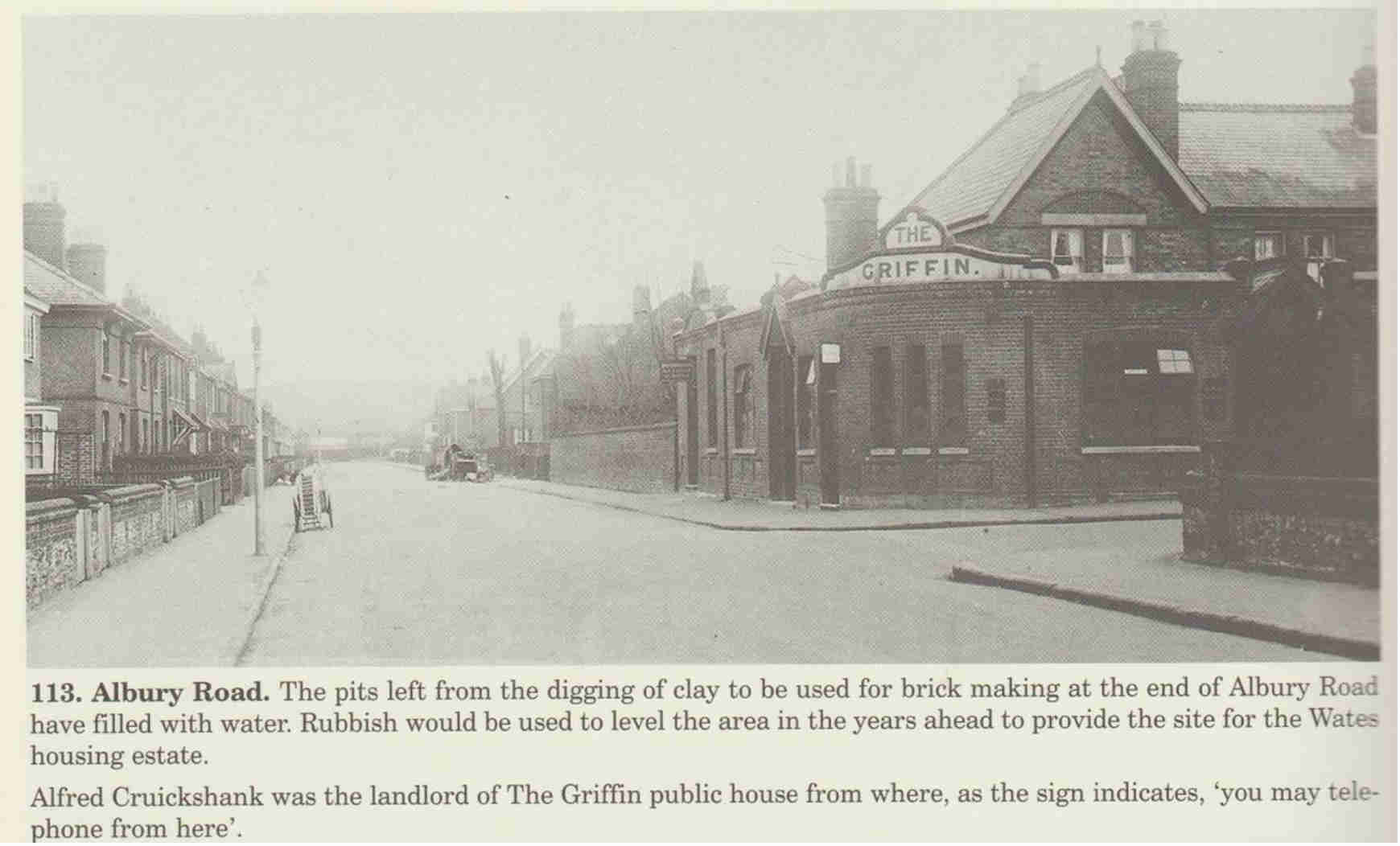 |
In June 1905 Capt Rawson played at the club and presented a silver challenge cup for a future internal competition. His offer the previous year of a challenge cup to be contested by clubs in the division had not been taken up.
At their Annual Concert in November 1925 Mr Peter Stephens, the South Merstham Bowling Club President, “understood that a new club had started in Merstham, but he did not think that would have an adverse effect on the South Merstham Club.” This new club was probably the Merstham Village Bowling Club. In his Captain’s report Mr W E Richards commented “They were handsomely beaten by the strong St. John’s Club, better known as the Woodlands Club.”
In February 1931, at a general meeting, the club agreed to join the Redhill & District League.
The map below shows the Griffin Hotel in 1933. The Surrey Mirror records a match between South Merstham and Merstham Village on 13th May 1933 – the former losing at home 52-54.
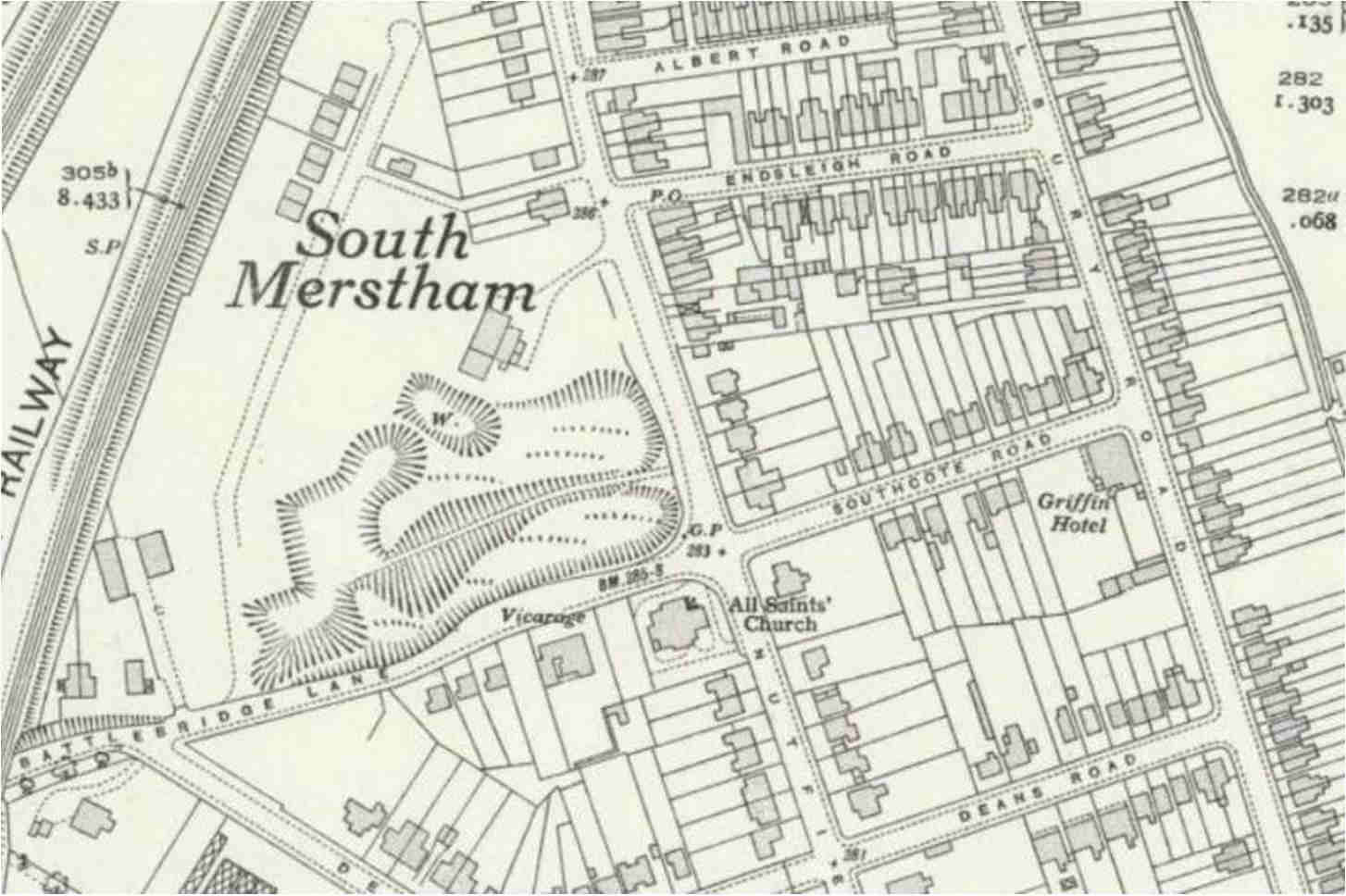 |
The Redhill & District League table of September 1935 does not include South Merstham and the club does not feature after 1933 in newspaper reports.
The Griffin Hotel was demolished and replaced by the Limes Public House - a 1960s bow-windowed building - which was built on the bowling green of the earlier pub.
Foster’s Temperance Hotel Bowling Green – Woodlands Bowling Club
The Dorking & Leatherhead Advertiser of April 23rd 1910 reports:
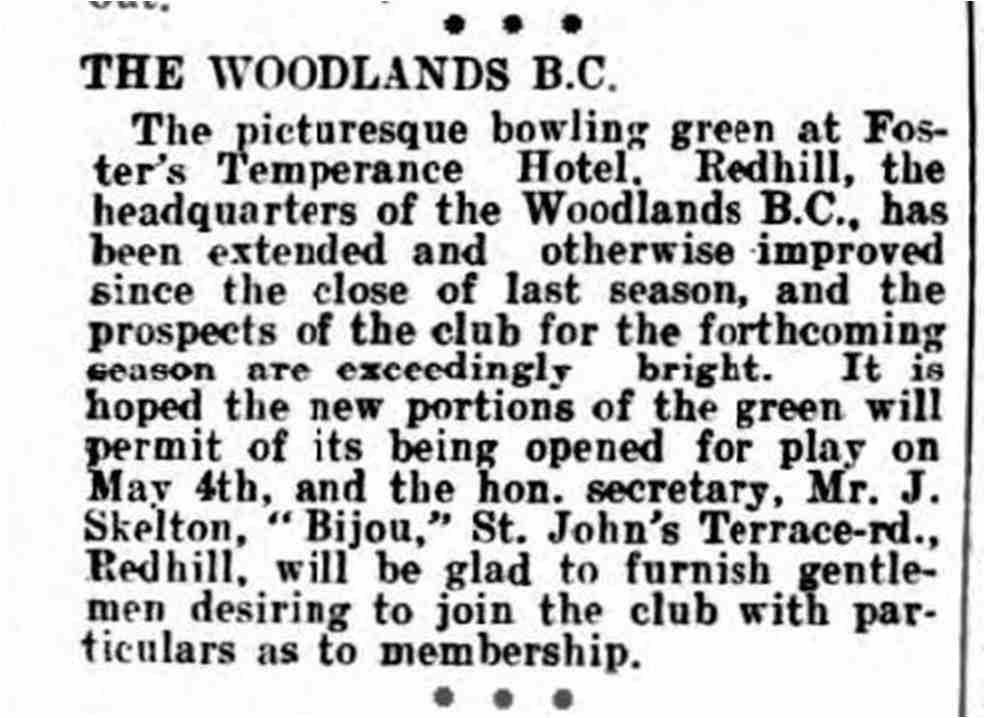 |
The club had only been formed recently as at the Redhill (Subscription) Bowling Club’s Annual Dinner in October 1909 the Club Secretary J H Marsh said they had played one friendly with the new Woodlands Club.
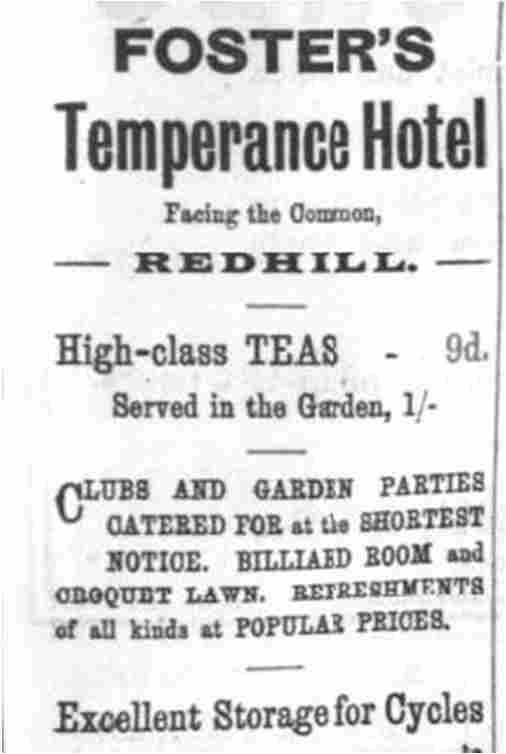 |
The hotel was situated on the east side of the Brighton Road near The Cutting with views over Redhill Common and the town. The 1913 edition of the Ordnance Survey shows a large building matching photographs of the Temperance Hotel to the west of the Vicarage.
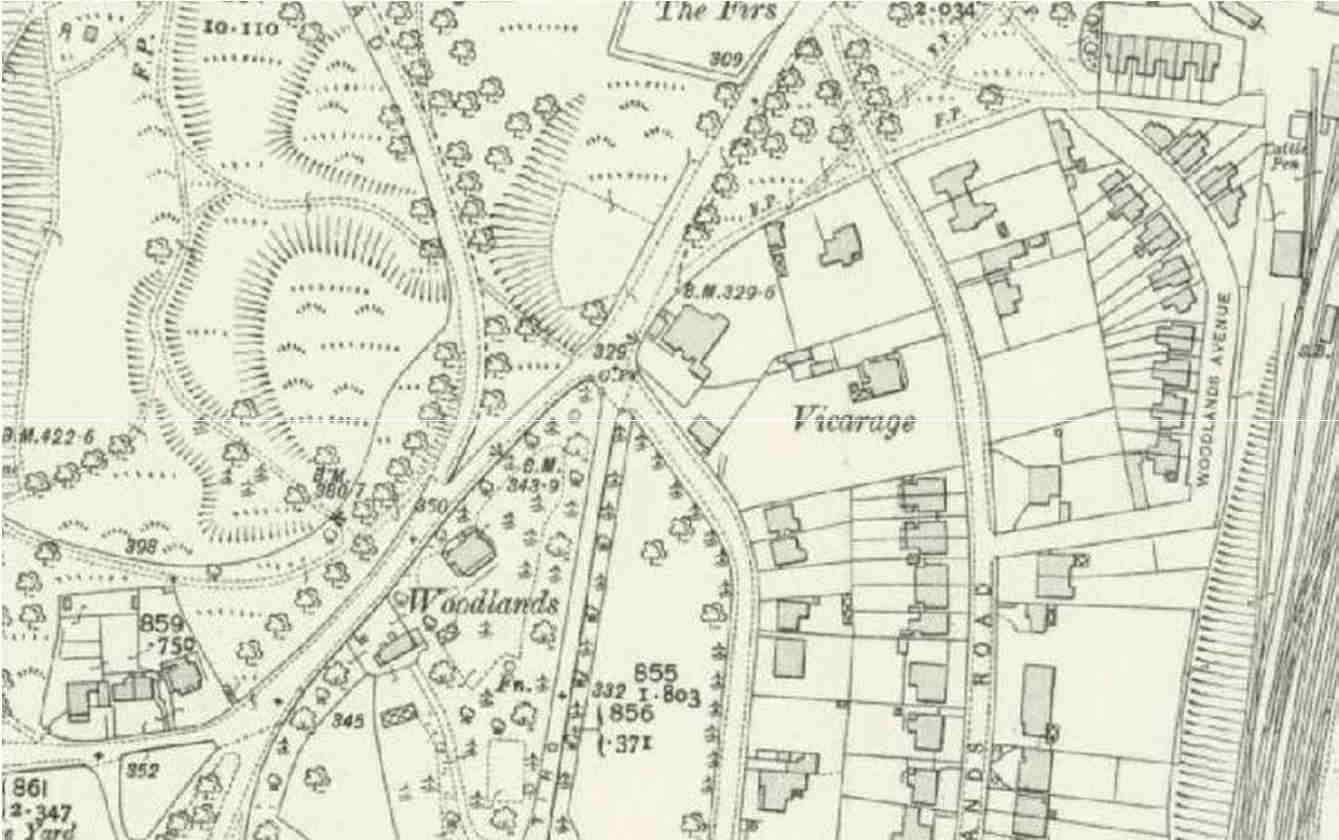 |
In January 1913 there was a major fire at the hotel which rendered it uninhabitable. It was pulled down later in 1913. In October 1913 a scheme was launched to provide St. John’s Church, Redhill, with parochial buildings on the site on which formerly stood Foster’s Temperance Hotel. The cost was estimated at £5,000. The parish hall was later to be built here – see section on the St. John’s Green below.
Gloucester Road Green - Redhill & District Bowling Club/Redhill Bowling Club
The Gloucester Road site was leased by bowlers who previously played at the Warwick Hotel from member Charles Edward Gatland. He owned a Men’s Outfitters in Redhill High Street. He sold the shop to Foster Brothers in 1912 on his retirement. He bought a large house in Clarendon Road with grounds bordering Gloucester Road. It was to here that the newly named club moved in 1912.
The location is shown below on the 1913 survey to the south of Gloucester Road with Clarendon Road on its western boundary. The site was later to be acquired by the Methodist Church whose new hall opened in April 1934 followed in the 1990’s by their current church when the last vestiges of the bowling green disappeared. Also of note on the survey is a small rectangular bowling green just north of the junction of Gloucester Road and London Road. See the next section of this monograph for comment on this.
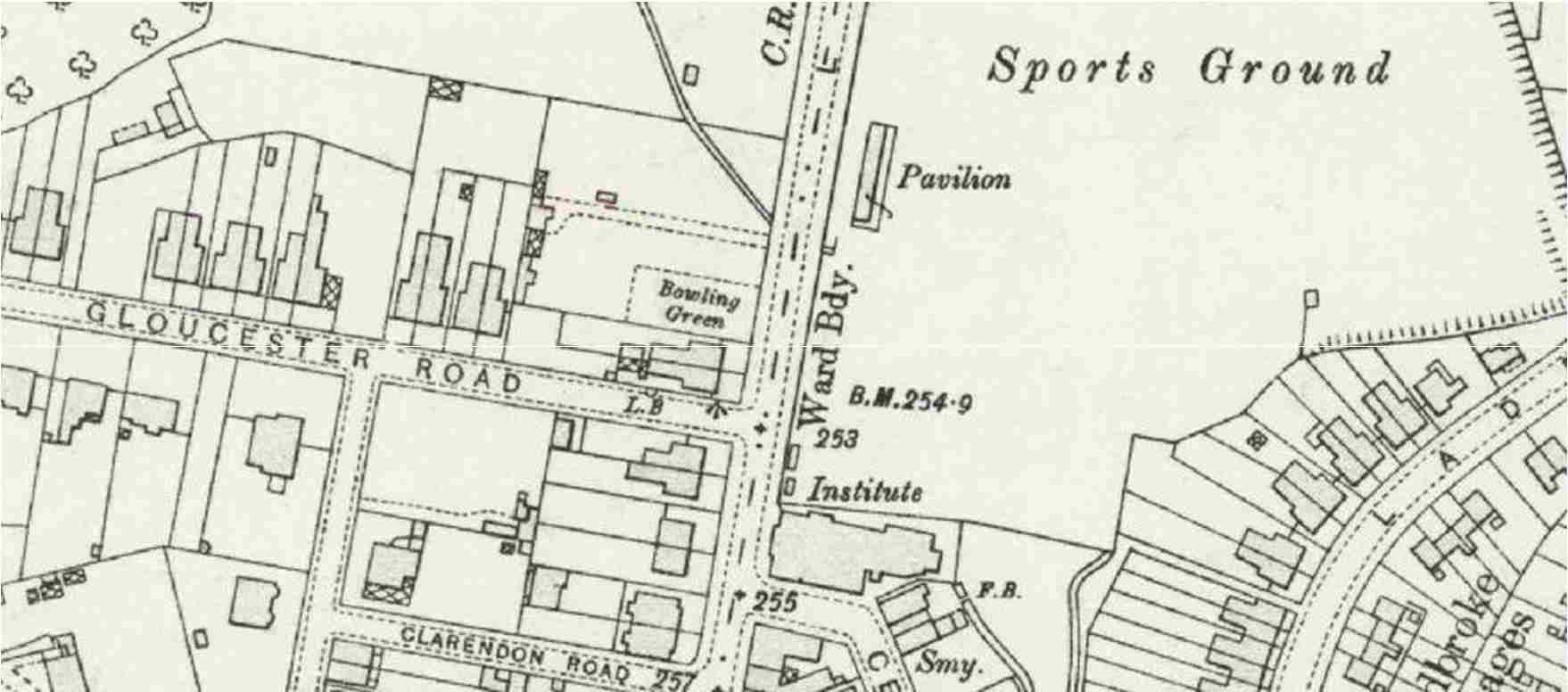 |
On Wednesday 22nd June 1912 Lady Leconfield delivered the first bowl on the new green – see photo below. The ceremony was presided over by the Mayor Mr F E Lemon who was also President of the bowling club. The turf was obtained though the kind offices of Col R H Rawson MP from a tenant farmer of Lord Leconfield – a Mr Robinson of Sedlescombe. It was “skilfully laid by Mr J J Pink of Merstham.” Mr Pink was a bowler and was Secretary of Merstham Bowling Club.
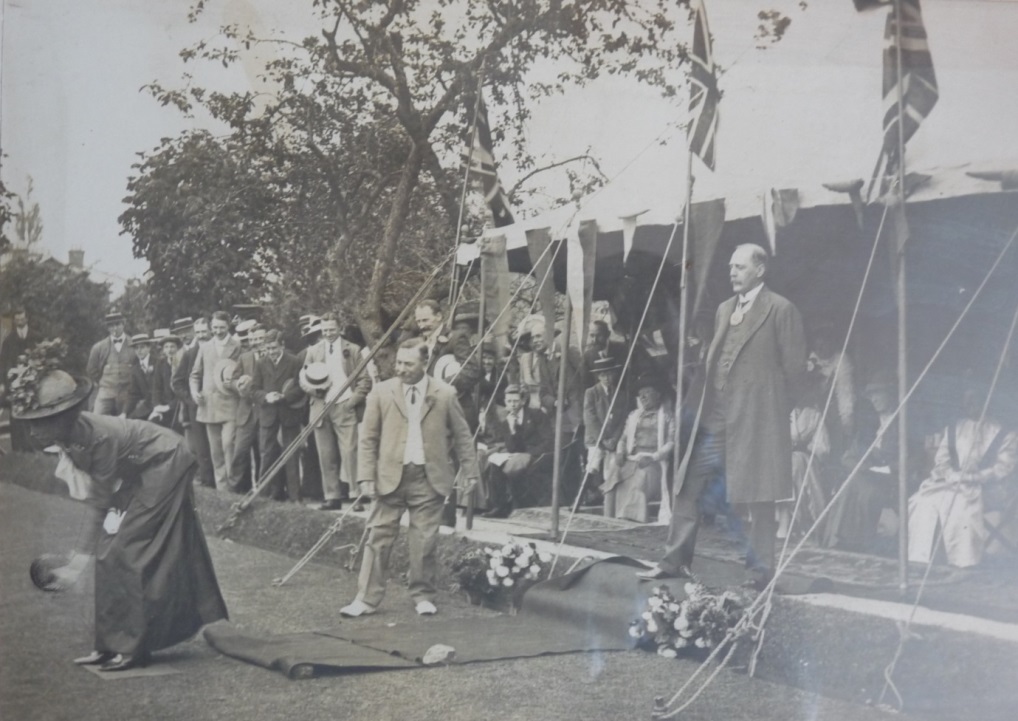 |
At its Annual Meeting on 9th December 1918 the club announced that the club name in future would be the Redhill Bowling Club. At the meeting the club subscriptions were doubled from 10s 6d to £1 1s. Mention was also made of a new league of clubs in the London District. Affiliated clubs would have to have Cumberland turf greens – this ruled out Redhill for the time being!
The meeting also noted the winning by Redhill & District of the Surrey Chalet Cup for rinks for the second time in three years again against Farnham. In November 1916 this cup had been presented at the Surrey annual meeting to S Mill, J C Waterman, G Linter, & W M Grice (skip) (left to right in the photo below) and H Little (standing) who was called upon to play in the final round. The Surrey County Bowls Association records show that the re-titled Redhill Bowling Club won the trophy for the third time in 1920 this time beating Weybridge.
Of note in the photo is the club badge worn by Mill, Waterman and Grice. This has a castle gatehouse emblem similar to that on the Borough of Reigate coat of arms. Linter is wearing a Surrey County badge. The town of Redhill was the main constituent of the east ward on the Borough of Reigate.
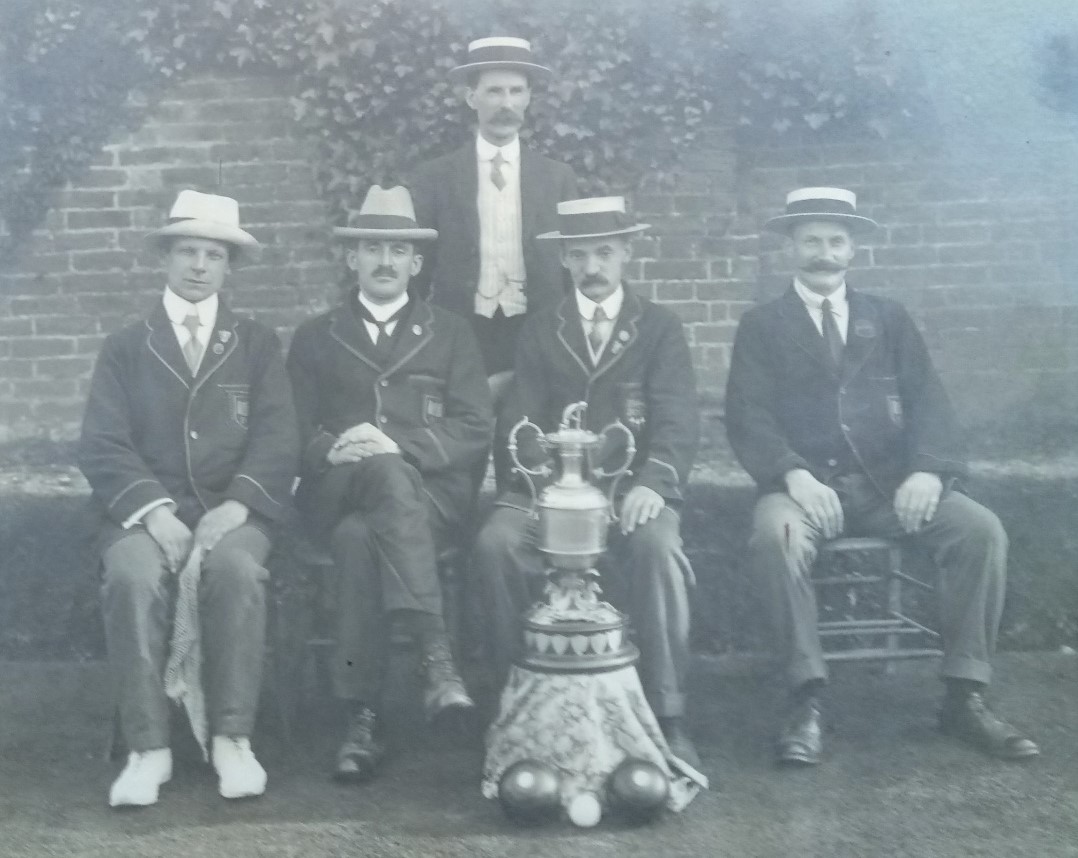 |
At its formation the club had many associations with the Reigate Division MPs and Reigate Borough councillors which probably resulted in the choice of this emblem. Later this castle gatehouse was incorporated in the Redhill Bowling Club (Wiggie) badge.
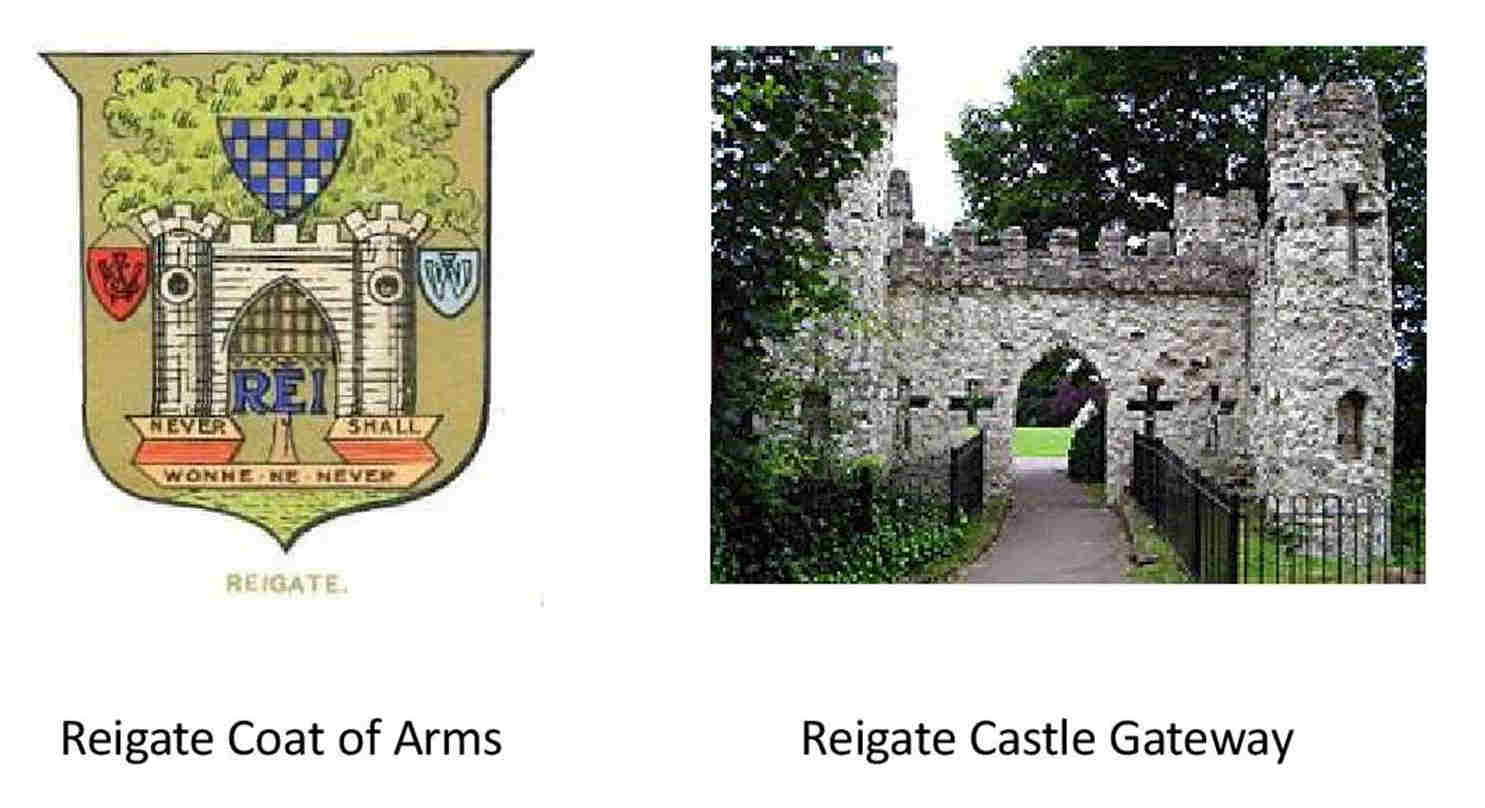 |
Waterman and Grice were Surrey singles champions in 1915 and 1920 respectively. Grice played for England in 8 seasons between 1921 and 1936.
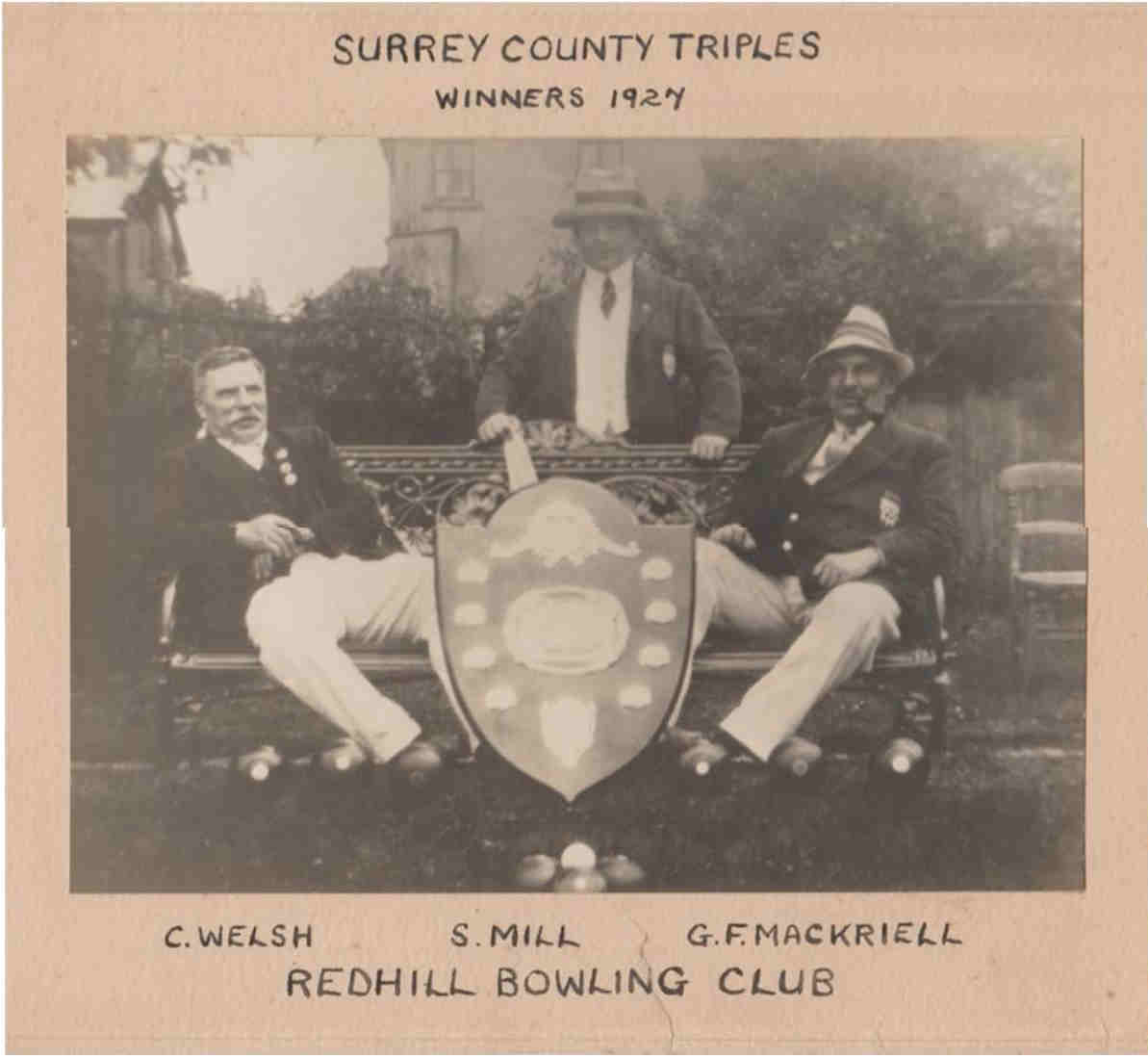 |
Mill appears again on the county honours board when he was in the team shown above as the Surrey triples winners. This was the first golden era for Redhill bowlers.
During the 1920’s the club competed in the Mid-Surrey League and their opponents included Caterham, Chipstead, Dorking, Epsom Park, Gonville Park, Kenley, Reigate Priory and Wimbledon St George’s. In 1925 the club won the league title for the 6th time in succession.
The membership was predominantly male middle class. Appendix A lists the professions where known of the participants of the 1929 match against Old Wiggie Ramblers (for photo see Wiggie Homestead Bowling Green.
London Road Bowling Green
A small bowling green is shown opposite the southern end of the Sports Ground (later the Memorial Park) in London Road on the 1913 Ordnance Survey map of Redhill – a part of survey map is shown on Pg16 in the Gloucester Road Green section above.
The site was developed in the early 1930’s for a public baths and fire station after an earlier architectural competition in 1914. Nothing is known at present about the ownership and usage of this green.
St. John’s Bowling Green – St. John’s Bowling Club
In December 1928 the St. John’s Bowling Club held its annual supper. The event was presided over by Rev L G Mannering (Club President). The club “has been fifteen years in existence” so dating it to about 1914 – see paragraph below. The 1911 survey for the 1913 edition of the Ordnance Survey shows a large building matching photographs of the Temperance Hotel on the site of the parish hall with space for a bowling green behind.
At another annual supper in January 1939 the Club Captain Mr W B Parker stated “In the old days there was a public house in the neighbourhood of St. John’s whose garden was used as a bowling green. St. John’s Bowling Club however was founded in 1914 after a decision to start a bowling club in connection with St. John’s Bible Class.” The public house could have been Foster’s Temperance Hotel – see section above on the green located there.
At the season opening in May 1923, the President, the Rev B B Slater “with the third bowl on the new rink had a toucher.” At an annual supper of the period comments were made about “the lengthened green”. It is possible that the green used by the St. John’s Club was the same one that existed at the Temperance Hotel with the green lengthened to the south.
The 1934 Ordnance Survey showing the Parish Hall is included below.
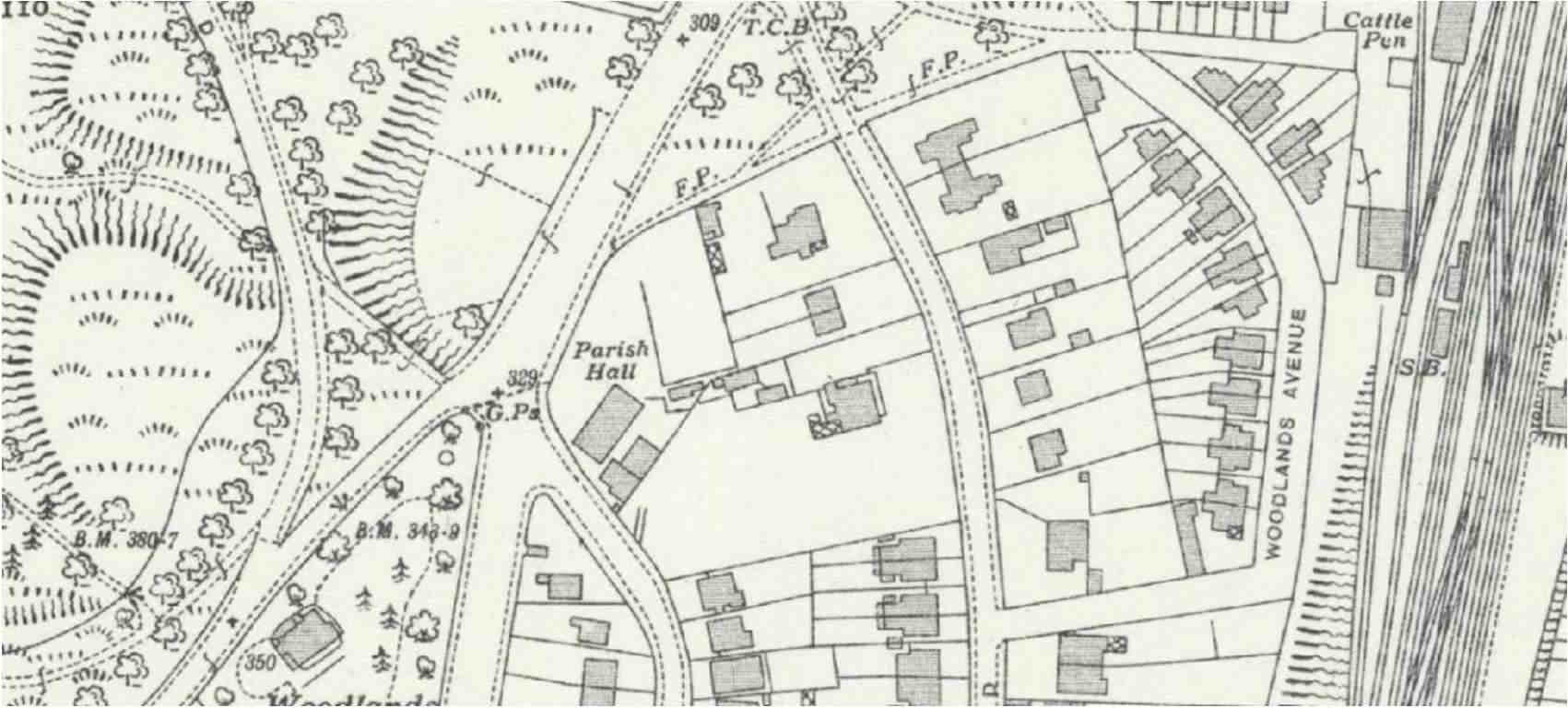 |
At the annual supper in January 1938 W B Parker (Vice Captain) referred “to the long association with Vicars of St. John’s and the Club”. Member W Baily “...reminded the company that for years the Club had provided bowls for those who needed some form of recreation, but were not in a position to pay the subscription demanded by the larger club.”
The club continued after the Second World War but almost certainly closed in 1999 as member Ron Howland has retained a cup he won in 1999 in line with the club’s policy at closure. This is confirmed by the records of Battlebridge Bowling Club which show that 10 members joined them from St. John’s in 2000.
Ron Howland recalls that the church had given the club notice prior to selling the land to develop another parish hall elsewhere. The land was not sold and the bowling green is still in evidence today.
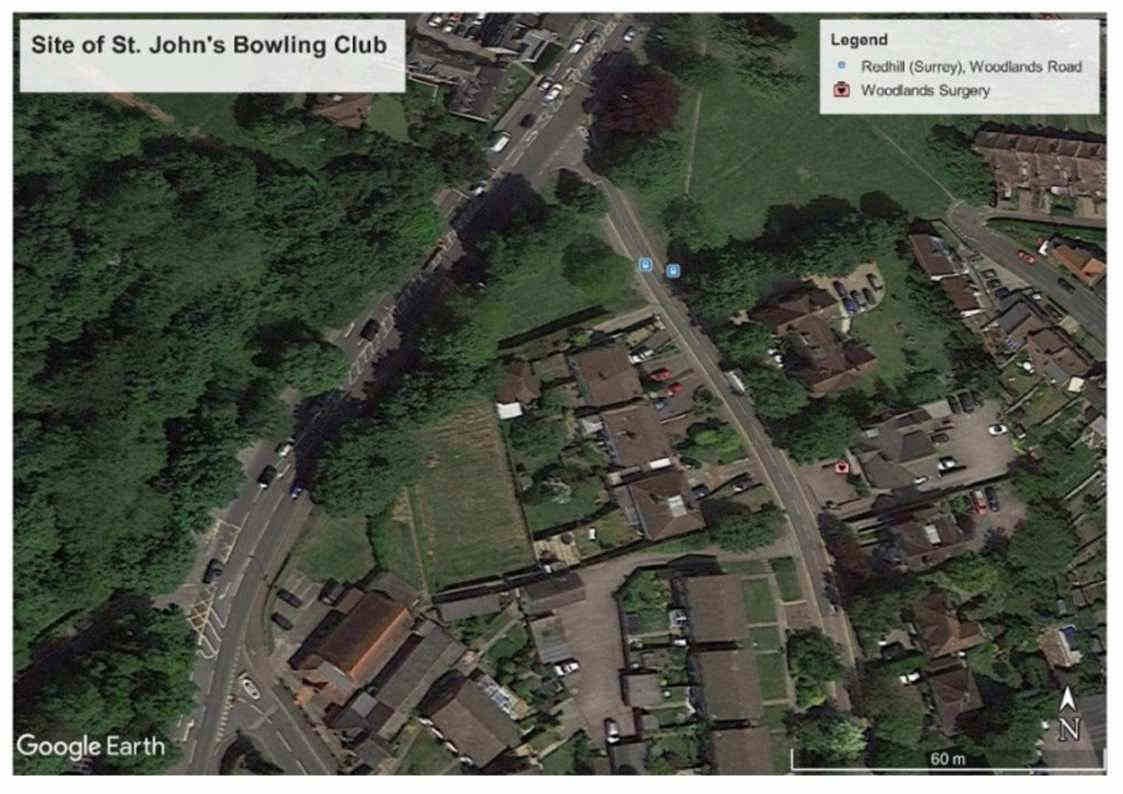 |
Holy Trinity Bowling Green – Holy Trinity and/or Monson Bowling Club
Holy Trinity Church was built in 1906 and consecrated on 2nd January 1907. A First World War memorial hall - “The Victory Hall” – built to the north was opened in October 1920.
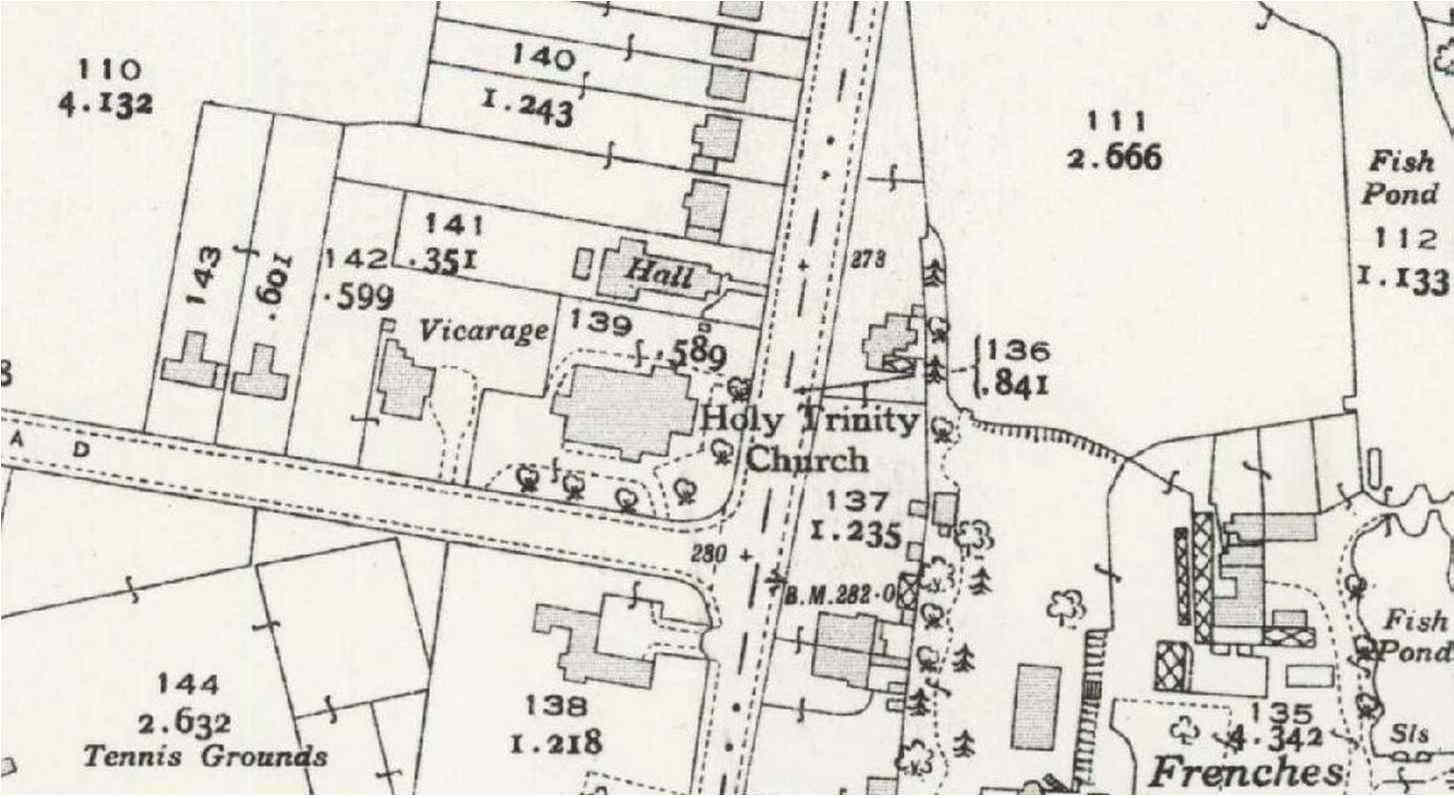 |
Three years later in June 1923 Holy Trinity are recorded as playing a friendly at home against St. John’s on the green behind the memorial hall. It is not clear if this was the correct team name or the Monson Bowling Club. An away return fixture was played in July 1924 - one player for Holy Trinity was Bignall (see 1943 match below). None of the other players appear in the honours rolls held for this club for 1929 onwards forming part of the Battlebridge Bowls Club records.
The origin of the club name is unclear - it may be a coincidence but within the parish organisation was the Monson Road Mission Hall. In 1927 the Surrey Mirror reports on a match between Merstham Village and ‘Monson Road’ whose team included A Bignall, C Bignall and Thornton making this theory most likely.
The earliest Monson fixture so far identified was away at Betchworth in August 1925. It is on record that the Monson Bowling Club Men’s Championship Singles was competed for in 1929 with the winner H Thornton being the first name on the Vice-President’s Challenge Cup. This cup has a London hallmark of 1927.
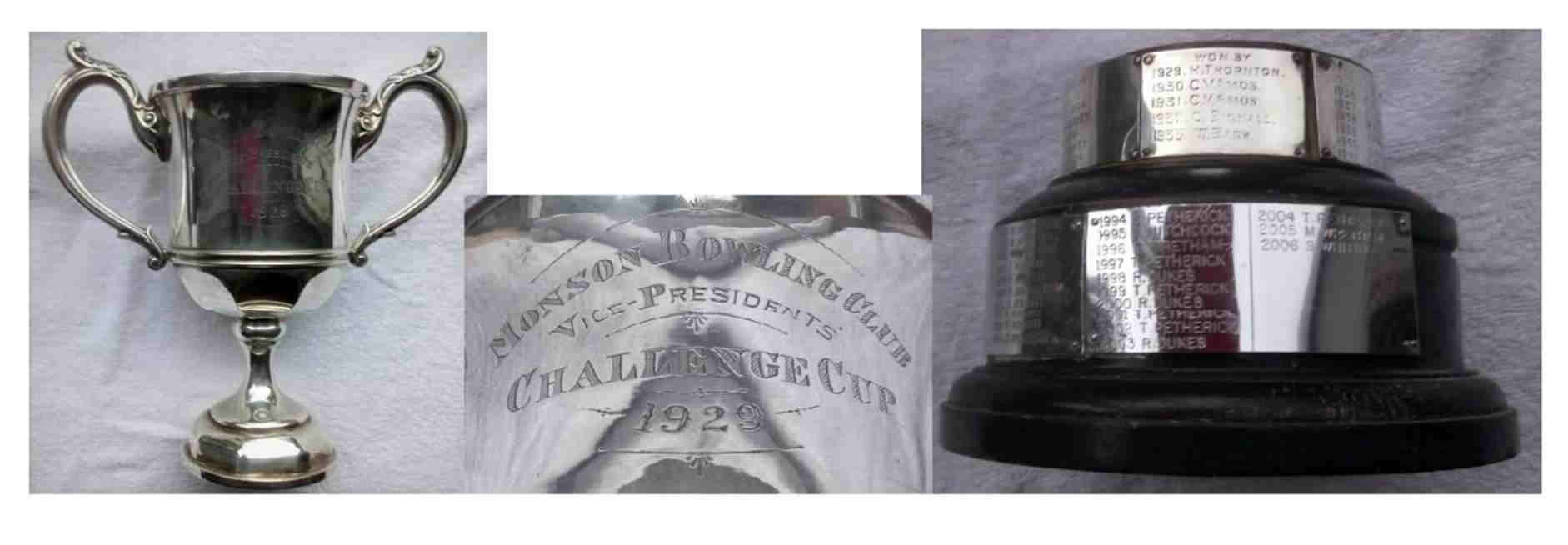 |
Another cup with a Sheffield hallmark dated 1924 exists for the Handicap Singles. This is inscribed “Battlebridge B.C. Men’s Challenge Cup” but not dated. The accompanying base has a record of winners also going back to 1929. A search of The British Newspaper Archives up to 1950 for Battlebridge Bowling Club in Surrey found no mention of this club at or around 1929.
At the Monson Bowling Club Presentation Evening at Holy Trinity Memorial Hall on Friday 21st November 1930 the Club President, Rev Canon H F S Adams vicar of Holy Trinity, officiated. He remarked that the club had won the challenge cup of the Redhill Bowls League. This was the first year of this league and the cup had been presented by W M Grice of Redhill – the international bowler and later England Captain. The President also commented on the men of the club “who came not only to play, but to put in a good deal of hard work on the green”.
The church’s centenary handbook describes the many parish organisations in the 1930’s and the list includes the Monson Bowling Club.
The Rev Harold R Oakley, Club President and Vicar, took the chair at the annual meeting in the Memorial Hall on Friday 4th November 1949. “A presentation of a case of pipes was made to Mr F H Brooker, the green ranger, in recognition of the work he has done to improve the green.”
Nora Wretham, whose grand-father James Bignall played for Monson Bowling Club, recalls that the 3 rink bowling green was situated on the strip of land immediately to the west of the Memorial Hall shown on the 1933 survey above.
The Surrey Mirror of Friday 9th July 1943 records a match the previous Saturday against Reigate Priory and lists 5 Bignalls playing for Monson including J Bignall.
Roy Dukes recalls that the Curate at Holy Trinity (Rev Philip King) wanted the land used by the bowling club for use by his holiday club which started in August 1961. The parochial church council minutes record that in 1962 the club gave notice of their intention to give up occupancy of the green and offered the pavilion to the church. The club then relocated to the council built bowling green at Battlebridge Recreation Ground – see Pg33 below.
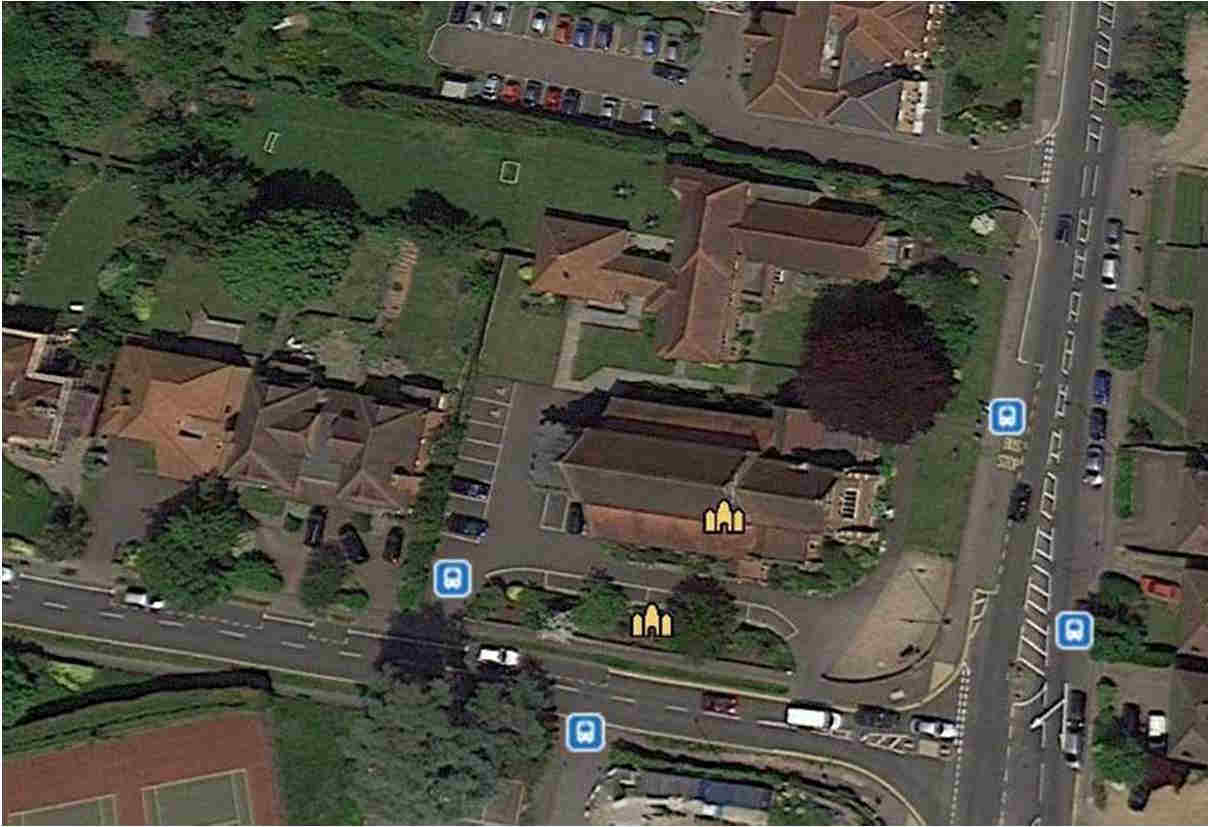 |
Rev Mike Hough, the current Vicar of Holy Trinity, tells us that this area on the top left of the above image is still called “the bowling green” by senior members of his congregation.
Merstham Village Club, Station Road North – Merstham Village Bowling Club
The foundation stone of the village hall was laid in August 1927 and the hall was completed the following year. In December 1929 at the Merstham Village Club Annual Dinner it was reported that “During the year, thanks to the generosity of Mrs P Sellon, a pavilion had been erected on the bowling green and the green itself had been extended and made full size.”
The photo below shows Station Road North with the station at the far end. The village hall is the last but one building towards the station. The final building became the Telephone Exchange.
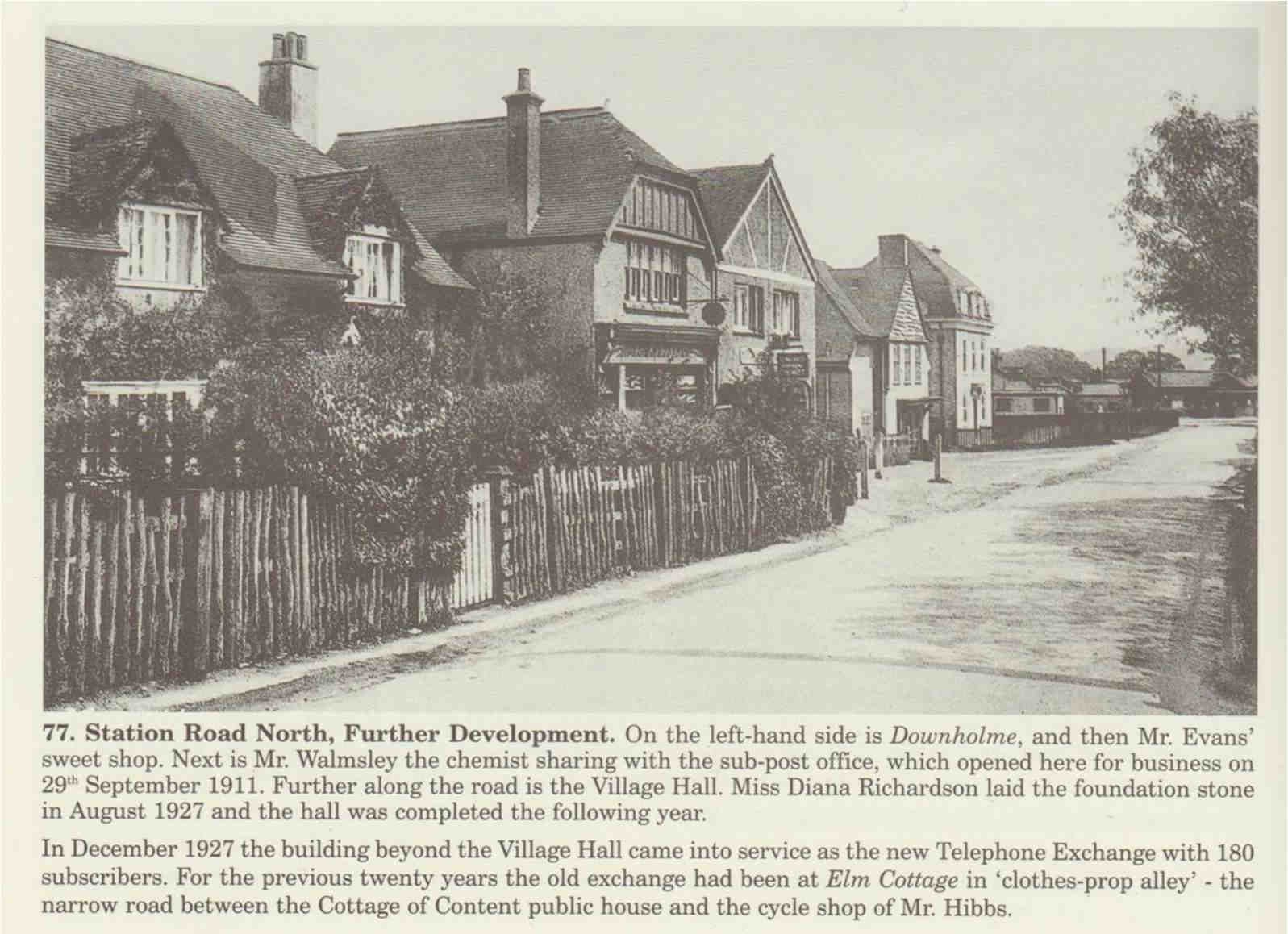 |
The bowling green and pavilion are clearly shown on the Ordnance Survey of the period.
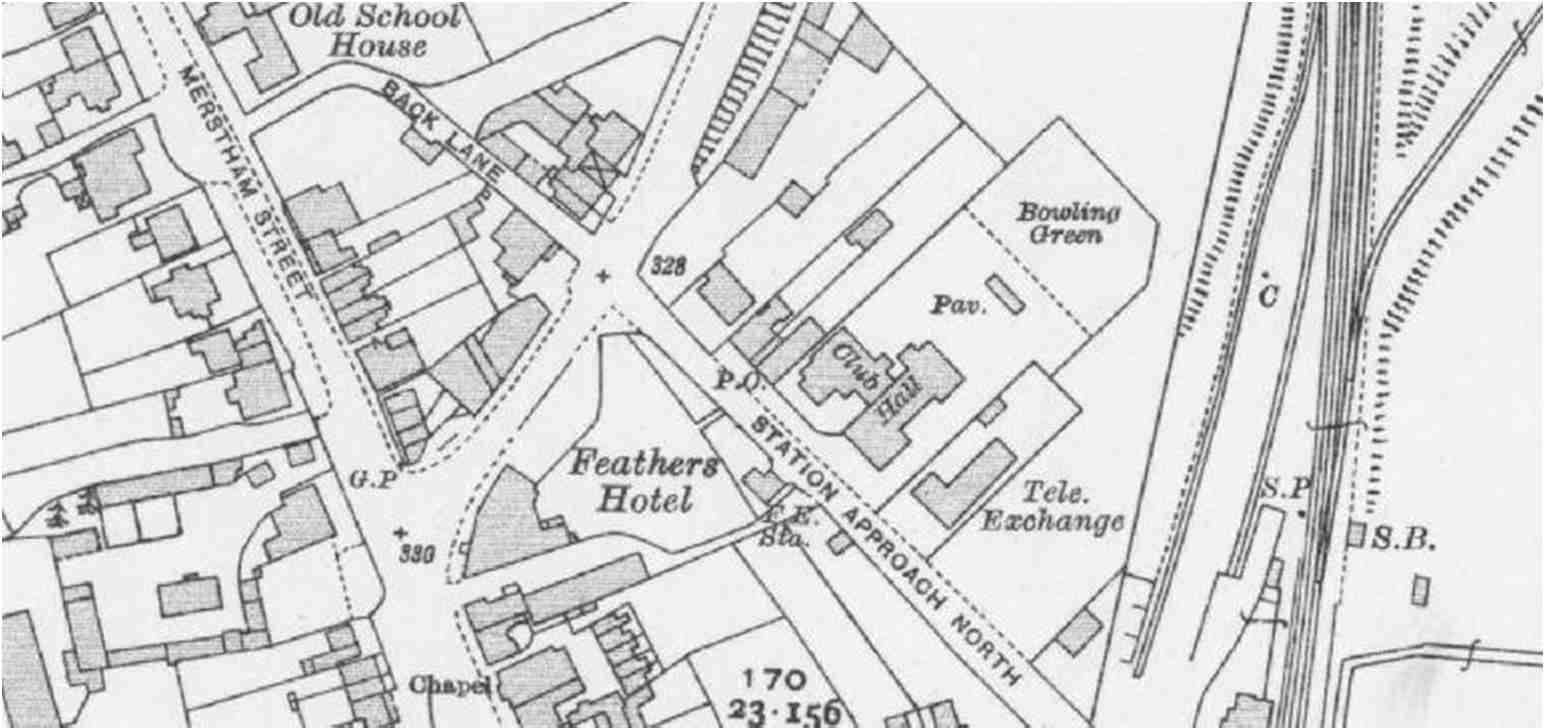 |
A notable achievement in September 1934 was the Club’s Ladies’ Captain, Mrs Taylor, winning the week long Ladies Open Tournament at Eastbourne - picking up the Pioneer Silver Cup valued at 20 guineas, a prize of 10 guineas and a set of woods.
At the Village Club Annual Meeting in February 1938 the Chairman, M C Bowley, proposed that a hard tennis court be built on the bowling green “which had been a continuing drag on the Club since it was laid.” A decision was deferred and not subsequently actioned as in 1941 the Village Club decided to turn the bowling green into allotments.
Redhill Bowling Green at Wiggie- Redhill Bowling Club (Wiggie)
By the late 1920’s the lease on the green at Gloucester Road was nearing expiry so a new green had to be found. The club was fortunate to have as a member Mr Arthur Trower of Wiggie who donated land from his estate for the establishment of a new green. A new limited company was formed, Redhill Bowling Club (Wiggie) Ltd. with shareholders buying £5 shares to fund the installation of a new Cumberland turf green and construction of a pavilion. The location is shown on the 1933 survey reproduced in the Wiggie Homestead section above.
Cumberland turf is from the intertidal areas of Morecambe Bay (Lancashire as was) and more often the Solway (Cumberland). It is covered by the tide at peak events. It has been described as “the stuff that saltmarsh lamb feeds on….. dense thick silty closely cropped stuff, probably used traditionally because this was the only naturally occurring short grass available before the invention of a decent mower.” It is deemed the premium turf for bowling greens. The new Redhill green was installed by James & Daniel Provan of Barrhead, Glasgow, under the supervision of their esteemed foreman Mr “Archie” MacKellow. High compliments were made at the opening to his being “one of the most tactful and skilful of foreman”. Daniel Provan was present at the opening on 8th May 1931.
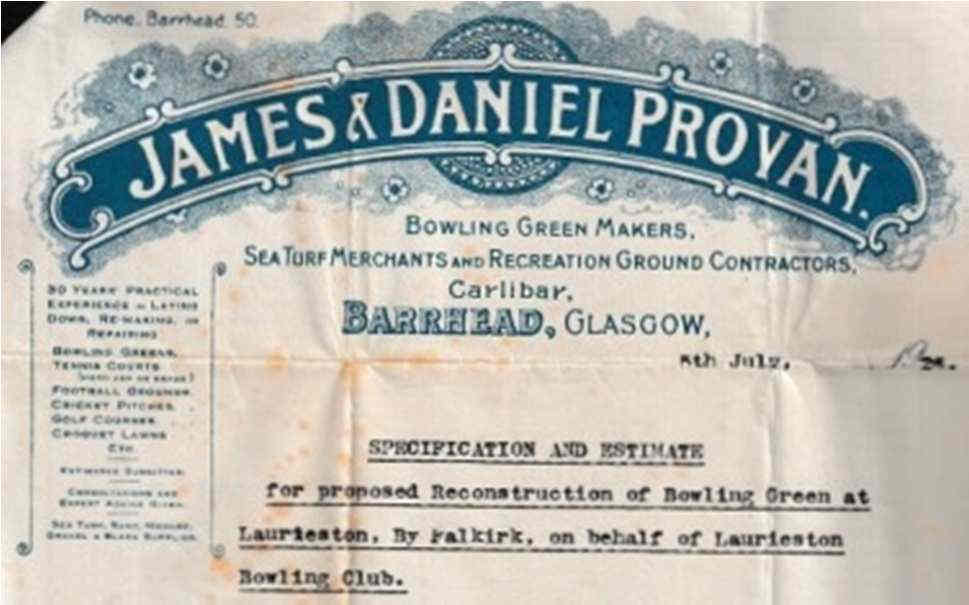 |
This was the second Cumberland turf green in the borough – the first was at Reigate Priory Bowling Club installed for their 1926 season which commenced 1st May.
The new pavilion is shown below. The timber construction was to have most unfortunate results some 50 years later.
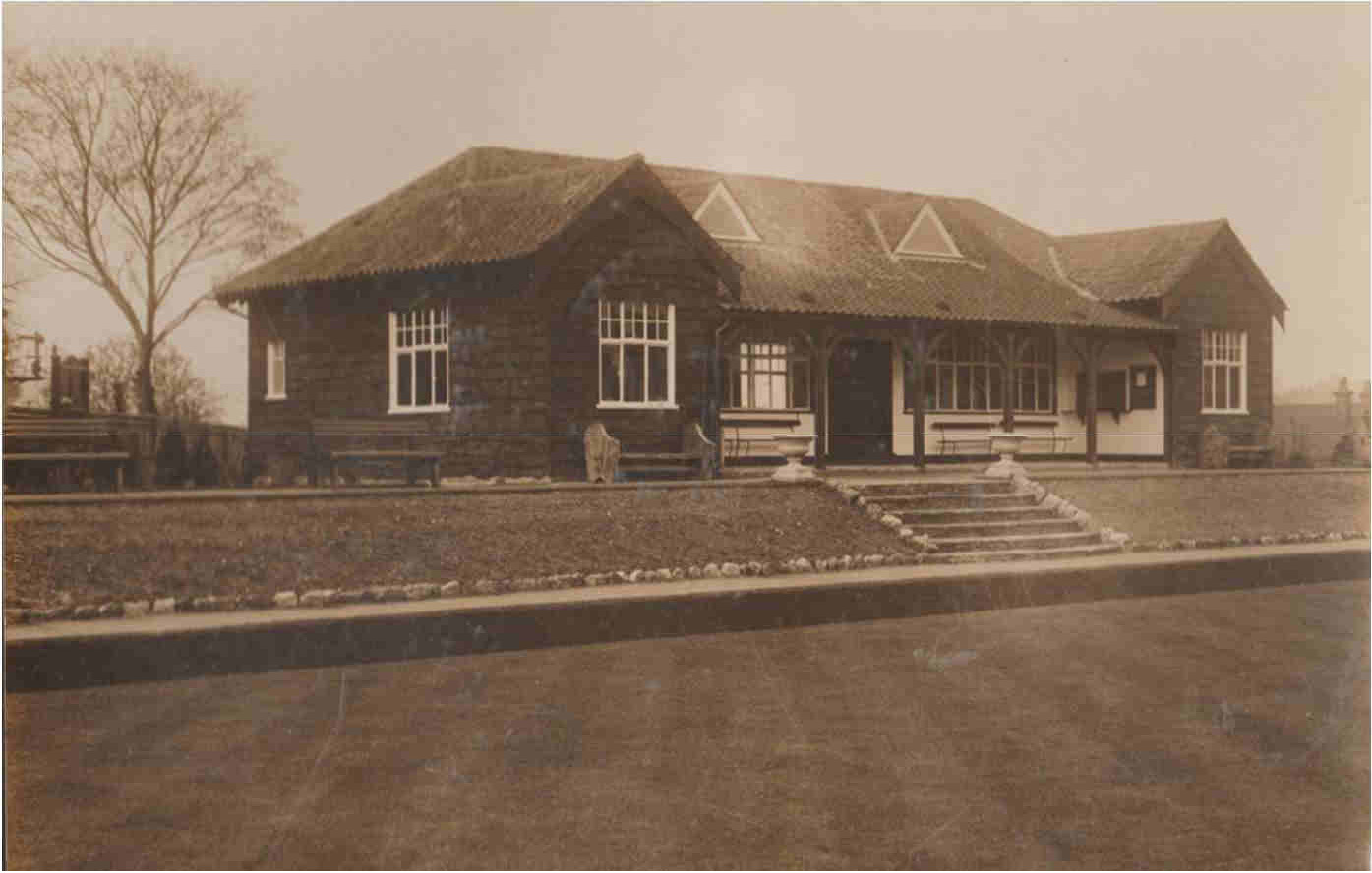 |
The green was opened by the Mayor of Reigate, Alderman Temple Newell JP CC. He first delivered a silver jack presented for the occasion by Messrs. J & D Provan. In the photograph capturing the event we see left to right Mr Daniel Provan, Mr E Stanton (President), the Mayor, Mr Arthur Trower and Mr W F Bound (Club Director).
 |
The Surrey Mirror of 22nd April 1932 reported on the “splendid facilities proved by this Club” and paid tribute to the five pioneers in the formation of the club – Messrs Chalmers, Grice, Mackriell, Stanton and the late W F Bound.
The new club had two England international players - W M Grice (1921-36) and E Stanton (1921), with C F J Walder to follow (1954-57). Grice had the honour of captaining England in 1933.
A new club badge was formulated in 1933 to include daffodils in recognition of Arthur Trower’s gift of land from his estate famous for displays of these plants. The castle gatehouse from the earlier badge sits alongside the daffodils. The Surrey Mirror report of a supper and music evening at the club’s pavilion on 21st February 1933 records the introduction of the new badge. The club was not satisfied with the current badge “which had been designed in a hurry.”
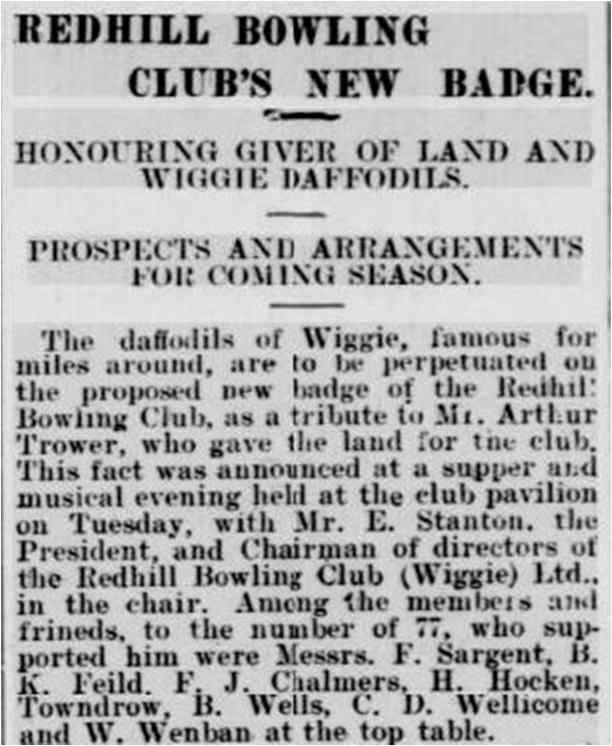 |
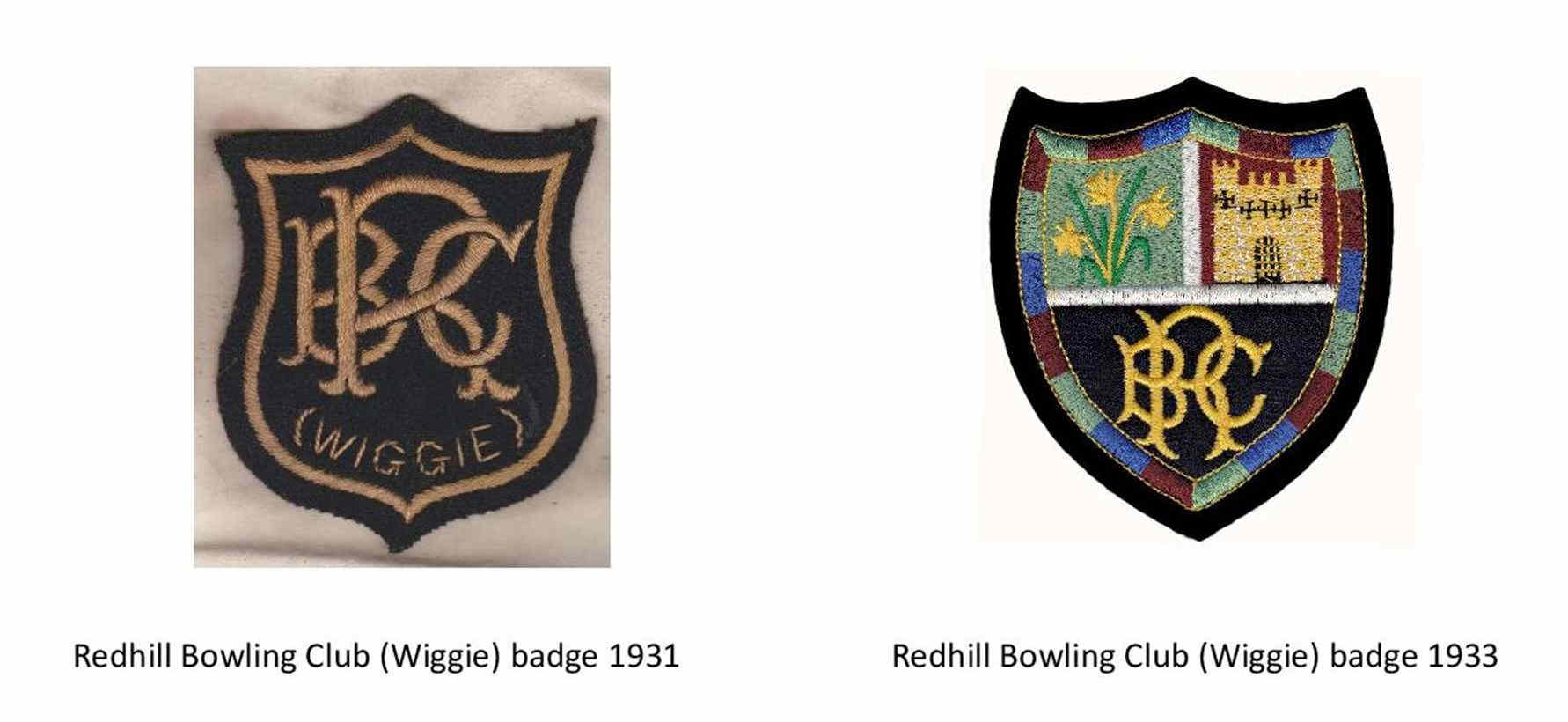 |
Other items of note reported that evening were the forthcoming match at Wiggie against Canadian visitors; the introduction of a Ladies’ Section on their own green from 1st May; and the proposal for “the erection of an archway in Ladbroke Road indicating the way to Wiggie.” The Borough Council raised no objection to the proposal but declined the suggestion that they provided a lamp.
The standard of the green was such that the Surrey County Bowling Association played matches there against South Africa in 1935 and the USA in 1948 at which C F J Walder skipped one of the Surrey rinks.
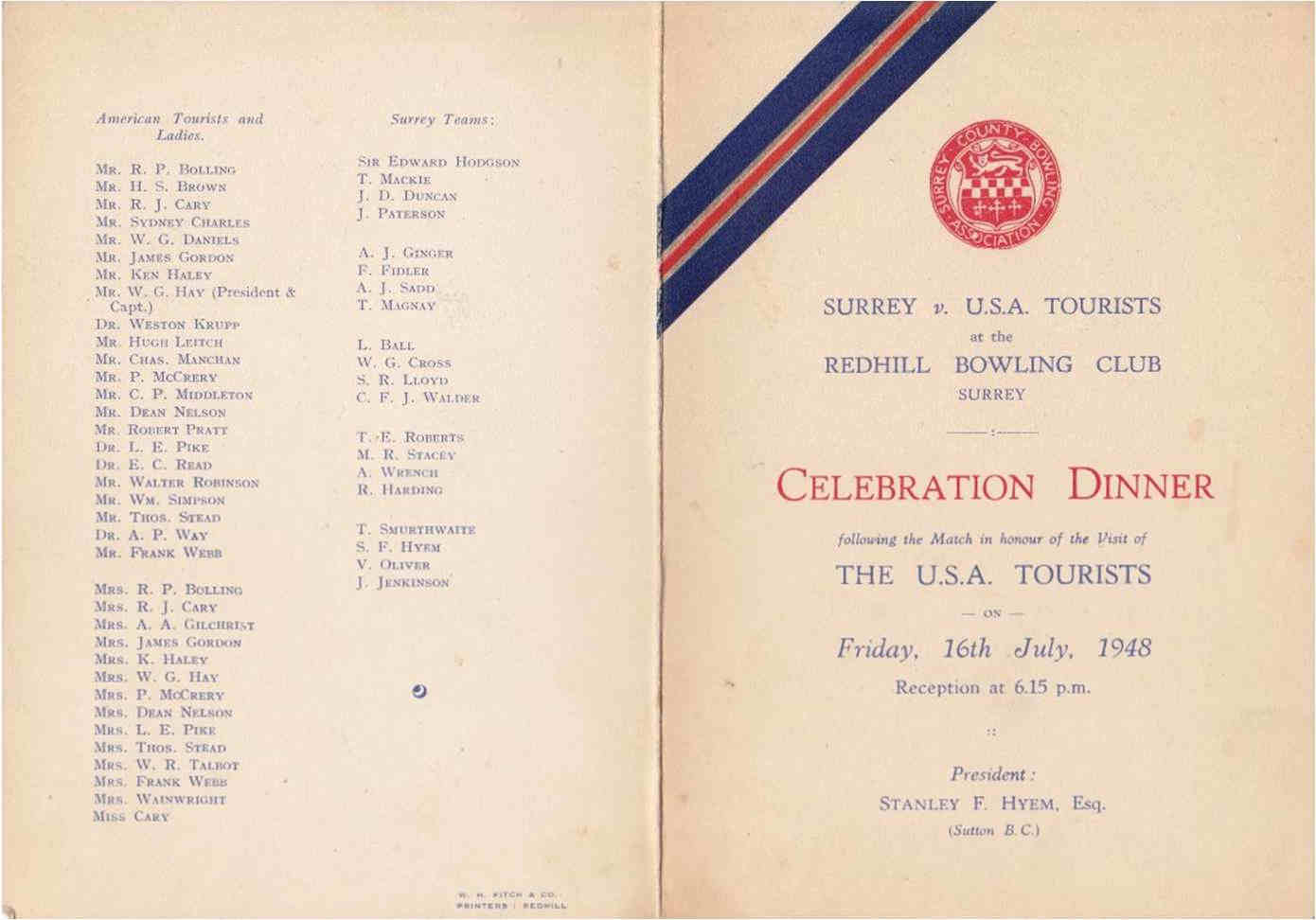 |
The Club won the English Triples and Fours Championships in 1947 – the first club to hold these two titles in the same year.
The Triples team was C H Godwin, S A Vallance and C F J Walder. In the Fours event this trio was joined by G F Godwin.
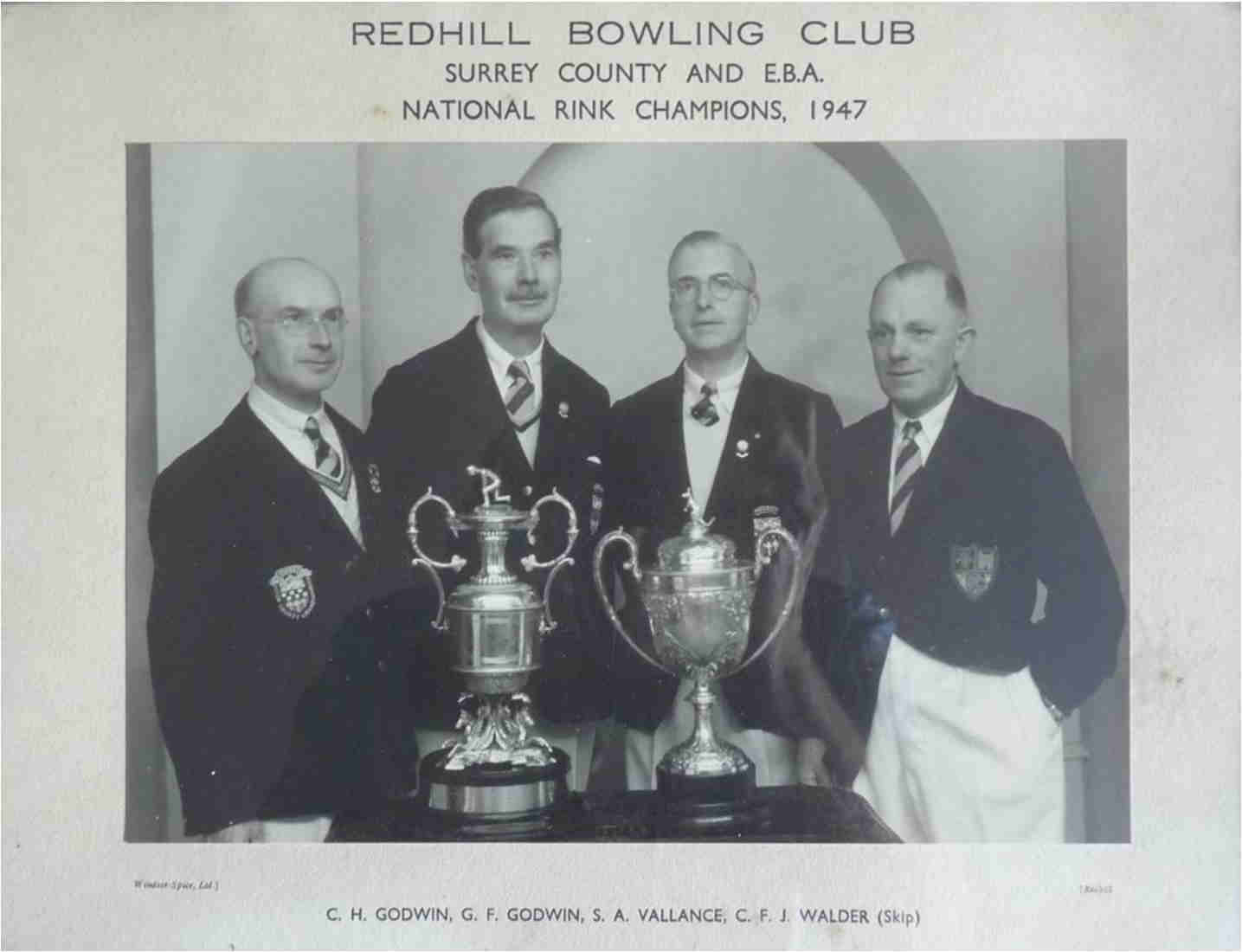 |
Several Surrey titles were won in this era – the Fours in 1945, 1947 and 1948; Triples in 1947 and Pairs in 1953. C F J Walder was Singles champion in 1937 and A A Walter in 1961. Another success in 1951 was winning the London & Southern Counties Pairs.
This was a second golden era for the club.
The club survived the total loss of its timber pavilion by fire in 1981. This was replaced in very quick time by a spacious brick and tile clubhouse.
In the early 1990’s Croudace Homes were developing the St. Anne’s site to the south of the club for housing. This resulted in the club losing its access from this area. Agreement was reached with the borough council for a new access and right of way through the Wiggie Allotments. With member’s support funding was obtained to build a new access track from St.Anne’s Drive and a car park. The current features can be clearly seen on the satellite image below. To the west are the Brighton Line Railway and Ladbroke Road.
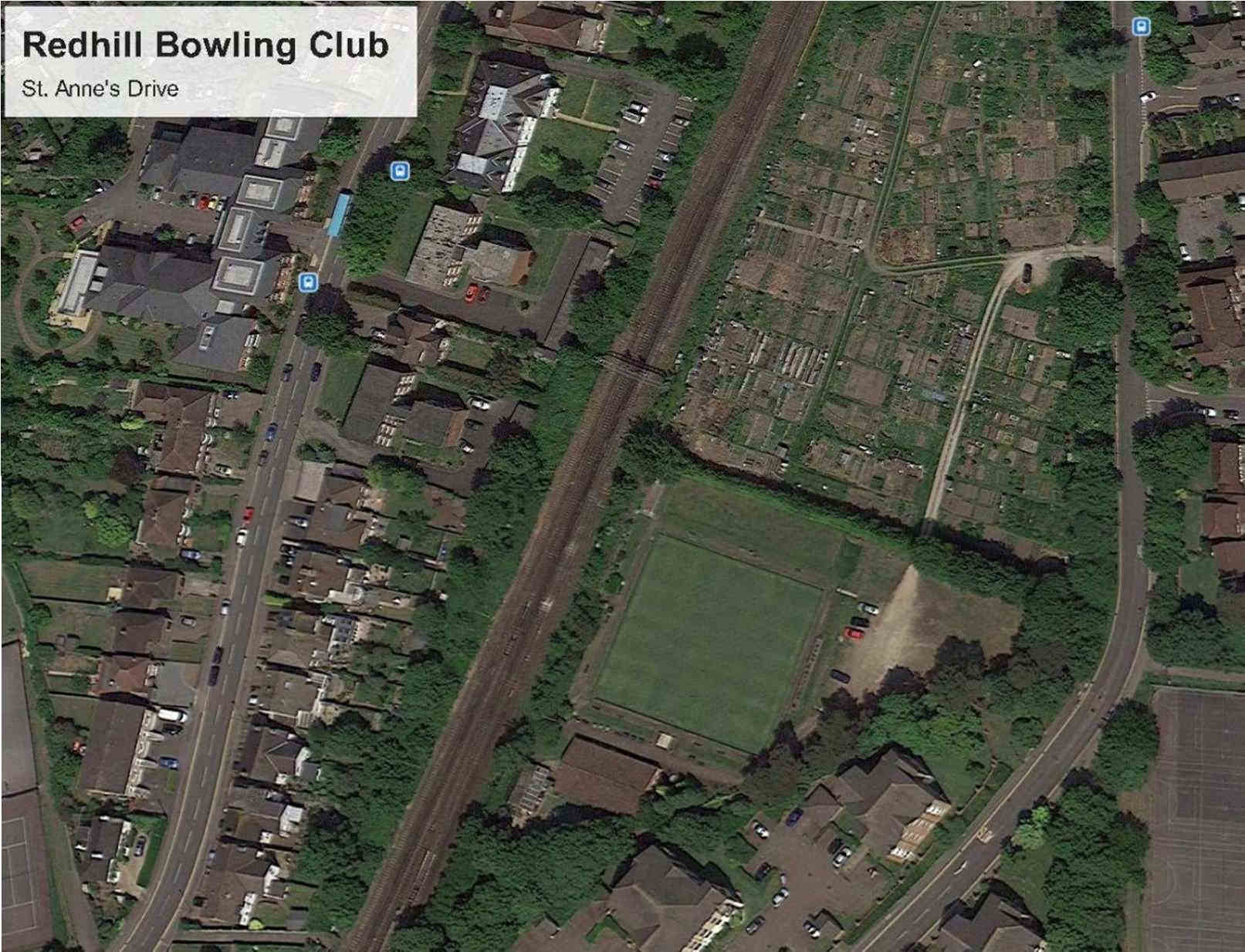 |
In 2010 a new company was formed, The Redhill Bowling Club Ltd., to remove the administrative burden of having shareholders. Also the club was granted Community Amateur Sports Club status by HM Revenue & Customs.
Redhill Bowling Club celebrated its 120th anniversary in 2015 based on the founding date registered with the county association. As can be seen from the history of the club’s predecessors at the Warwick Hotel and Gloucester Road this date is somewhat arbitrary but will remain without challenge from the author.
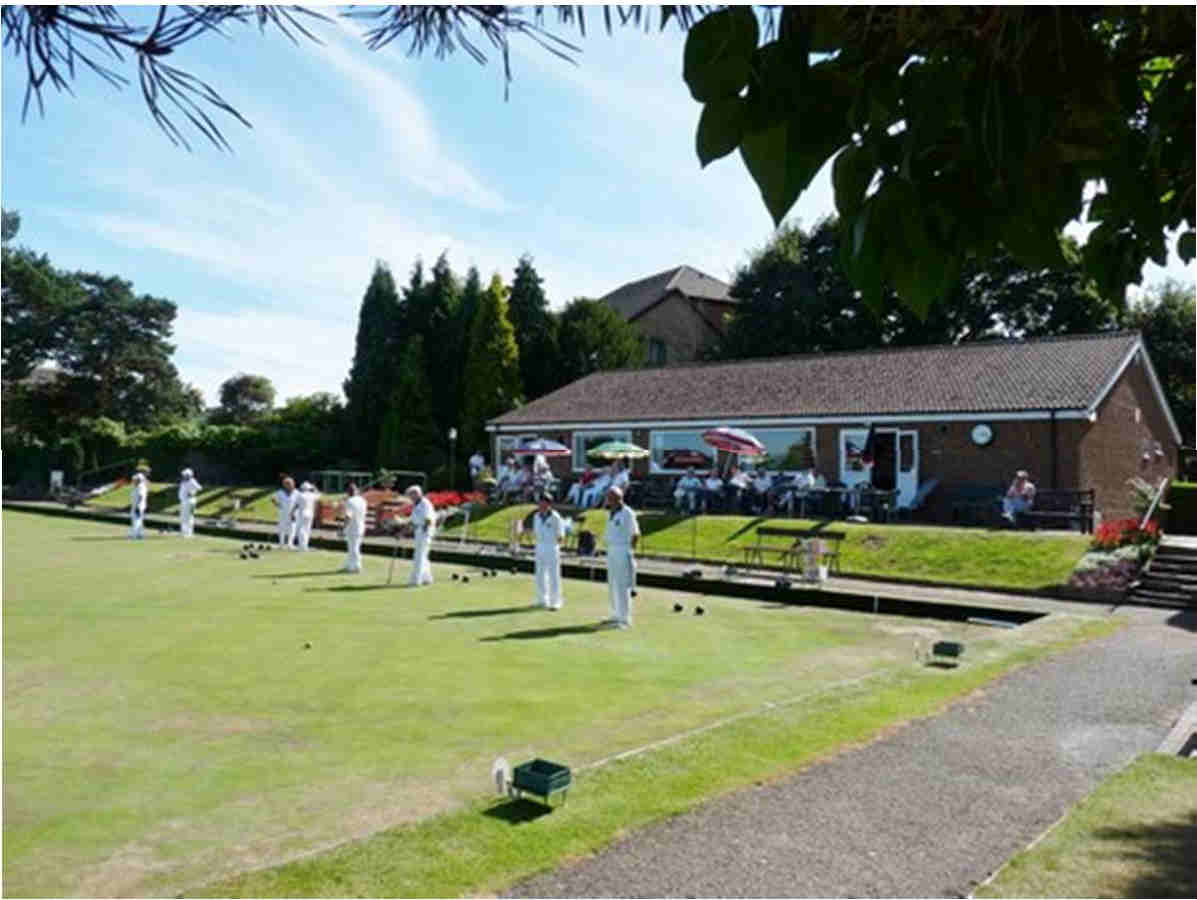 |
In 2018 the Redhill Pair of P Eales and B Gaunt won the London & Southern Counties Bowling Association Area C Pairs Final and were runners-up in the overall final.
The club currently competes in the Border League (Men) – winning the Border League Cup in 2016 and 2017; and the North Downs League (Mixed). In 2018 Redhill hosted a County Match (Surrey v Sussex Ladies) for the first time in many years and also the Surrey Over 55 Area Fours Final. It has been the venue for the Reigate & Banstead Borough Pairs since 2015. It is the only club still in existence of those listed in the Introduction and detailed in this monograph.
Battlebridge Bowling Green – Battlebridge Bowls Club
Legend has it that the Saxons had a victory over the Danes at Battle Bridge in the 10th Century. The discovery of swords whilst planting lime trees in the Battlebridge area of Merstham suggests a skirmish might have taken place there. Accordingly, two swords and a masonry bridge were adopted as emblems on the club badge.
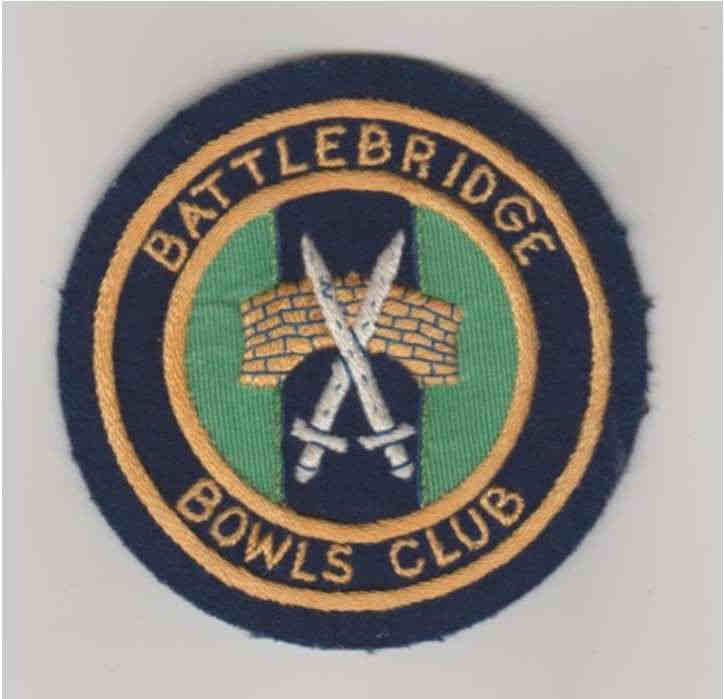 |
As described earlier the Monson Bowling Club vacated the green at Holy Trinity Church in about 1963. The bowling green at Battlebridge Recreation Ground became the base for the club which became the Battlebridge Bowling Club. It was on land owned by the Borough Council.
The continuity of the two clubs under different names is borne out by the engraved cups for the men’s championship and handicap competitions. These show an unbroken sequence from 1929 until 2006 except for a 5 year gap during the Second World War.
In September 2006 the club suffered a final bout of vandalism when arsonists attacked the adjacent athletics club building. From a report by the Redhill, Reigate & Horley Life - “The neighbouring clubhouse of Battlebridge Bowling Club also suffered severe damage. Michael Wretham, the bowling club's secretary, said: "It's pretty bad but we have been half expecting it to be honest with all the vandalism that has been going on.”
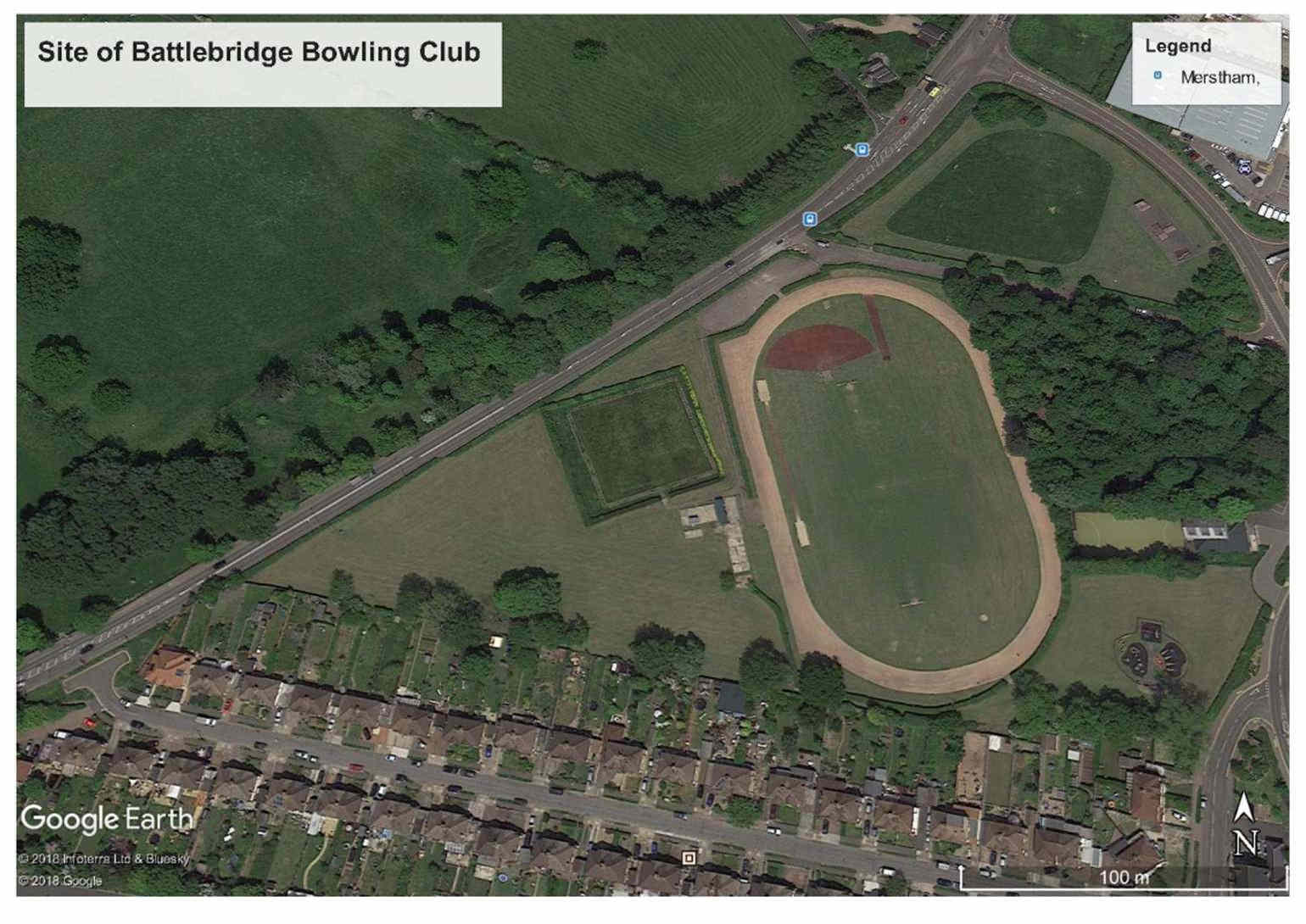 |
The club was unable to accept the financial arrangements proposed by the borough council for shared use of a new clubhouse and the club was wound up. Many of the members joined the Redhill Bowling Club.
BIBLIOGRAPHY:
- Culley, Derek Holy Trinity Redhill 1906-2006, Holy Trinity PCC 2006
- Dunne, Nigel The Redhill Story, D Canning Redhill 150, 1994
- Hooper, Wilfrid Reigate, Its Story through the Ages, Surrey AS 1945
- Moore, Alan A History of Redhill, Vol 1, A Moore 1999
- Moore, Alan A History of Redhill, Vol 2, A Moore 2003
- Moore. Alan A History of Redhill, Vol 3, A Moore 2013
- Trower, Arthur Our Homestead, Sampson Low, Marston 1910
- White, Peter Merstham As Time Goes By, P White 2002
OTHER SOURCES:
- British Newspaper Archive - Genes Reunited
- Census Records & Electoral Rolls - Ancestry.com
- Google Earth
- Ordnance Survey Maps Archive - Library of Scotland
- Survey & Terrier of the Parish of Reigate by William Eve, 1860-61
ACKNOWLEDGEMENTS:
I would like to thank the many members and ex-members of Redhill Bowling Club for their interest and suggestions - in particular; Roy Dukes for the information on Monson/Battlebridge Bowls Club; John Hoad for providing photographs, originally owned by the Buckland family, of the 1931 opening at Wiggie; the Rev Mike Hough, Vicar of Holy Trinity, for providing a copy of their Centenary Booklet; Ron Howland for information on St. John’s; Alan Moore for his information on High Trees Farm and the Trower family; Steve Whiting for information on Battlebridge trophies and Michael & Nora Wretham for their information on bowls at Holy Trinity Church.
APPENDIX A - DETAILS OF THE PARTICIPANTS OF OLD WIGGIE RAMBLERS v REDHILL BOWLING CLUB MATCH PLAYED 21st AUGUST 1929
TOP ROW
Alderman H H Pierce – RBC President of Hall Lands, Nutfield Marsh Road. Borough Councillor for 15 years
W M Grice – Family bakers at Redhill, Reigate & Dorking and international bowler
A Emsley – RBC Treasurer possibly (p) Post Office Overseer at 10 Warwick Road
A Donaldson – RBC Committee Member and 1920 Handicap Winner. Club champion in 1930
G Linter – Cycle shop 42-44 London Road
J(ohn) H Marsh – RBC Treasurer. Relieving Officer Registrar of Births & Deaths
W Wells – 103 London Road (Land) p Wells’ Nurseries (W Wells Jnr?)
E J Funnell – Post Office Clerk and vice chairman of Redhill Wednesday Football League.
SECOND ROW
A(lfred) A Rose – took over fruit and garden shop from his father William Rose
J H Matthews – RBC committee member and presented an honours board
H Potter – “Daddy” Potter of Worthing Bowling Club - a Surrey Mirror report tells how he reminisced at the repast after the match about previous exploits of the Wiggie Ramblers. Note W.B.C. badge on blazer.
A(rthur) Trower – owner of the Wiggie Estate and retired corn merchant
G(eorge) F(rederick) Mackriell – RBC Captain. Mackriell Builders & Contractors. 19 Chapel Road
G J Wallis – 22 Cockshot Road. For many years on the staff of the Reigate Water Company and Director of the Reigate & Redhill Hygienic Steam Laundry Co and the Reigate Stock Share & Investment Co.
E Dawson – p 4 Chapel Road (neighbour G F Mackriell). Commission Agent
FOREGROUND
J Chard – p William J Chard Hairdresser of 20 London Road Redhill
C Welsh – RBC Secretary p ex Fruiterer of 71 London Road, Redhil
This page was writted by John Davison
